#and we have even more blindfold photos to add to our collection
Explore tagged Tumblr posts
Text

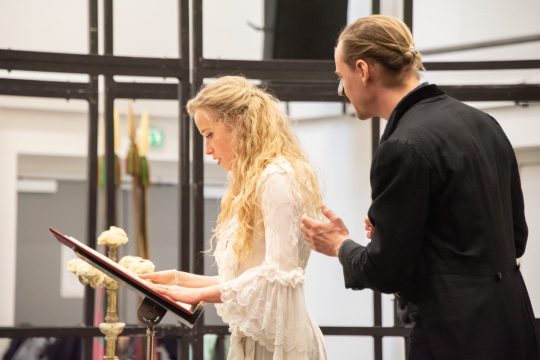
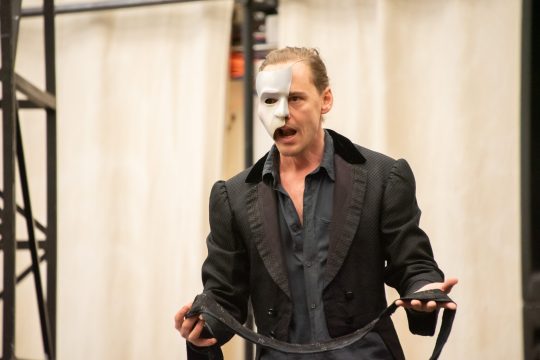


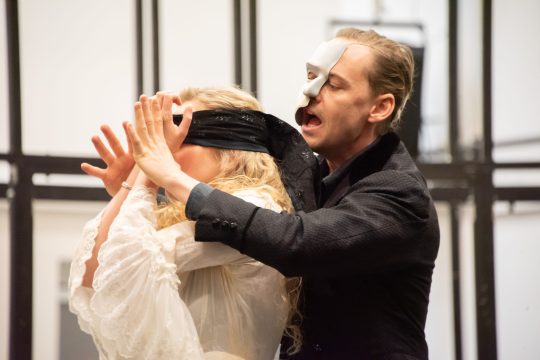
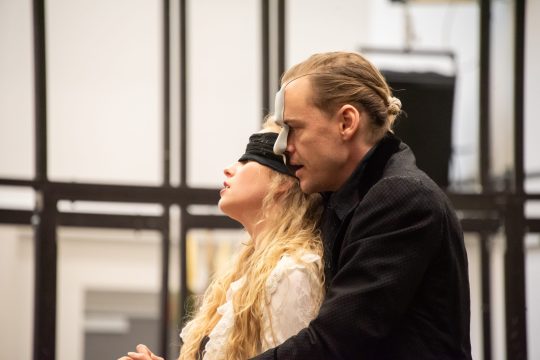
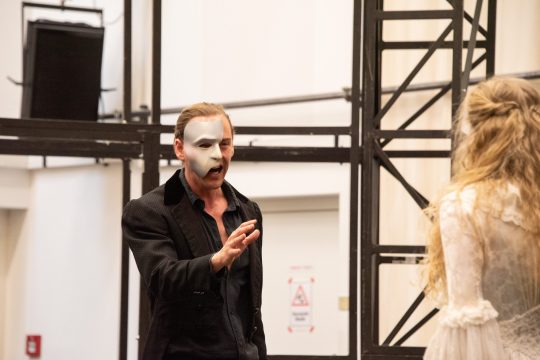





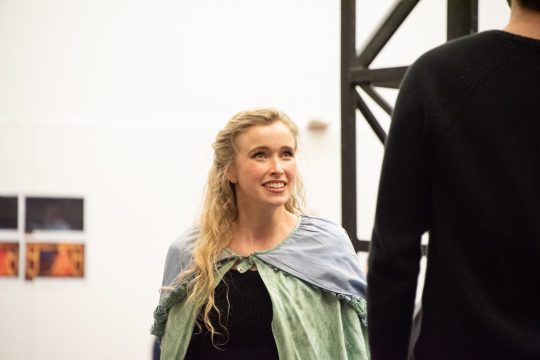
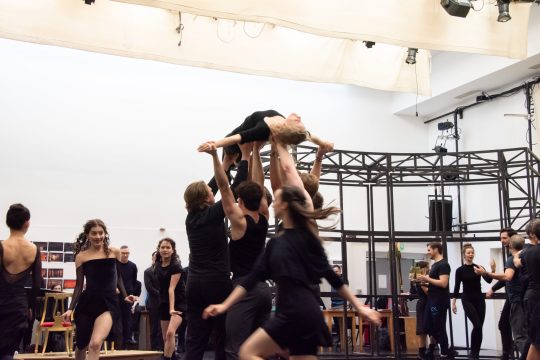
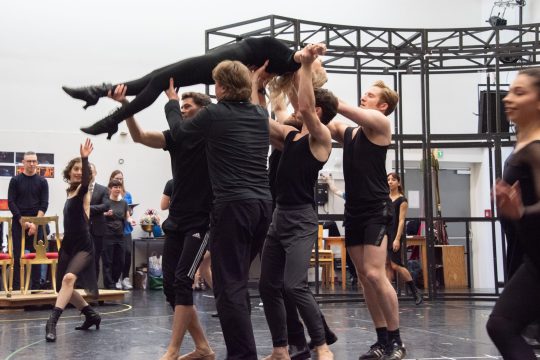
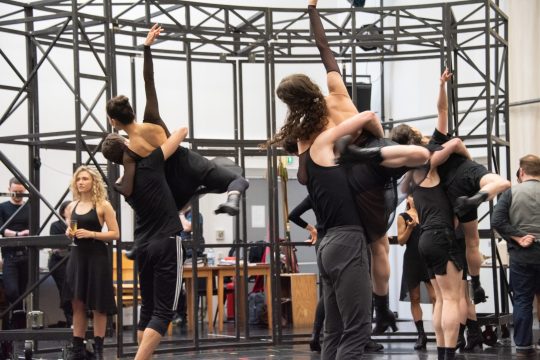



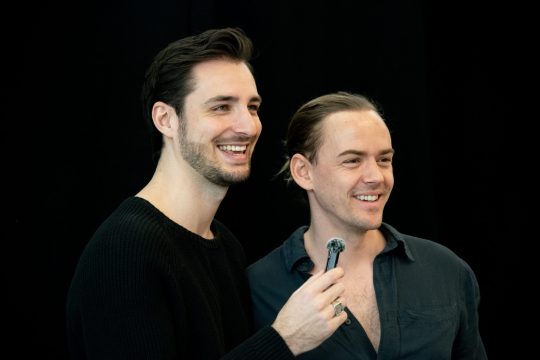
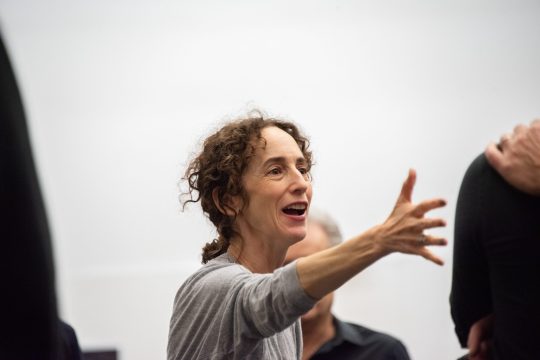


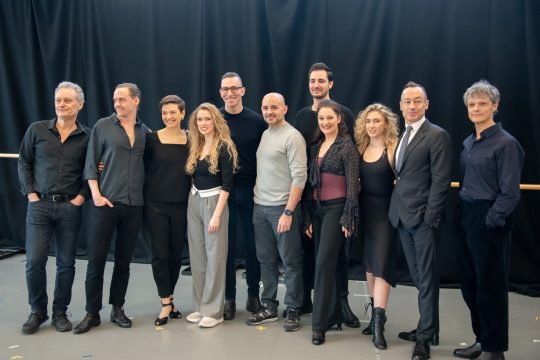
Photos from the POTO Vienna rehearsals.
#lisanne is adorable#love the anton/roy photo#and we have even more blindfold photos to add to our collection#anton zetterholm#lisanne veeneman#roy goldman#poto vienna#das phantom der oper#phantom of the opera#the phantom of the opera
65 notes
·
View notes
Text
— JUJUTSU KAISEN EPISODE TWO || FOR MYSELF

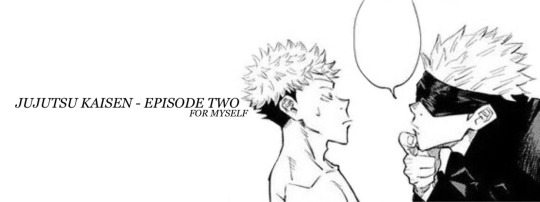

↳ featuring : itadori yuji + fushiguro megumi + gojo satoru + ryomen sukuna from jujutsu kaisen
↳ warnings : mentions of violence and EXTREME grammar issues
↳ form : story
↳ published : 09 february
↳ pronouns : she/her
↳ word count : 3.0k
↳ synopsis : within the jujutsu world, there were three famous clans to be aware of, the Kamo clan, Zenin clan and the Gojo clan. However, unknown to many sorcerers there was one last family that was known to be apart of the three, only for them to disappear after the golden era leading some to speculate that they had died in battle after the sealing of ryomen sukuna, but....
↳ previous episode : ryomen sukuna
↳ next episode : girl of steel
↳ barista’s notes : since you loved the first one so much, i decided to do episode two for you guys ╲ʕ·ᴥ· ╲ʔ also i am now addicted to genshin impact and right now, i am on adventure rank 19 and already cleared the ‘stormterror lair’ thing ʕ ㅇ ᴥ ㅇʔ i hope you enjoy this cup of classic black coffee (jujutsu kaisen) and come again soon!

BEFORE READING, I NEED YOU TO BE AWARE OF THIS:
1. the whole story belongs to Gege Akutami and the credits go to them and them only
2. the spell curses used belong to Tite Kubo due to them being the ‘Kidos’ being used on the manga and anime ‘Bleach’
3. this whole thing might be confusing and please don’t expect a part three because i will do it when i am ready or feel like i can at the right time ʕ ᵒ ᴥ ᵒʔ
4. i don’t know, if i am going to add this onto my masterlist since this was just for fun to be honest!

“What’s the situation?”
All of a sudden, a new voice came into the area leading you to turn your head to the side to find a rather tall male standing next to Fushiguro. From a quick glance, you could immediately inform yourself that had spiky white hair with a black blindfold covering his eyes, as he carried a paper bag on his arm while wearing a similar outfit to Fushiguro meaning he was another sorcerer.
“Gojo-sensei?! Why are you here?” Fushiguro asked in surprise, as he turned to look at what you assumed to be his teacher leading to the shadows around him to immediately disappear from sight.
“Gojo…” you muttered under your breath as you looked at the two male sorcerers right in front of you in horror as you came to the realisation of the situation you were facing.
‘Mother…..I’ve been found…..’
ꕥ
“Hey!’ the teacher cheerfully greeted while waving an arm to his student as a short greeting. “I wasn’t planning on coming, but man, you’re roughed up,” Gojo explained, before leaning forward as if he was taking a closer look at Fushiguro to which then caused lead to his hand to go into his pocket as he proceeded to pull out his mobile phone. “I should show the second years, face this way!” the sorcerer playfully stated as he began to take a multitude of photos of the ‘roughed up’ student, leading to the subject of his images to turn away while covering his face with his arm.
Looking at the scene with anxiety looming above you like a rainy cloud, you swiftly turned your head back to see if you could find a way out without both of them as well as Itadori noticing as they were distracted for the time being.
‘Shit, the only way I can escape is either jumping from this floor or going through the large gap behind me, but that’s gonna make them notice. What am I going to do?!’
“Ah! Miss, I know you are already there, so no need to escape!” Gojo suddenly stated, causing you to quickly turn back with widened eyes - surprised at the fact that he knew what was on your mind - to find the teacher waving at you with the same greeting he gave to Fushiguro as if he had known you for some time, like an old friend one would say.
‘Ah…..what a drag….’ you thought, as you then carefully picked up the katana that had landed in front of you when the curse was exorcised before slowly sliding it back into the casing that was behind your back.
“The higher-ups wouldn’t such up with a special-grade cursed object gone missing, so I stopped by while doing some sightseeing,” Gojo explained while looking down his phone like he was checking something when in your mind, you assumed that he was going through the photos that he took of Fushiguro due to his jolly smile that was displayed on his face.
‘Maybe, if you damn sorcerers got the cursed object sooner before the damn protective seal was ripped off, WE WOULDN’T BE IN THIS SITUATION!’ you argued in your head, as you slowly began to realise the reasonings why your mother never took a liking to the higher-ups, to begin with.
‘Those higher-ups are so useless, all they do is command other sorcerers to do their dirty work while acting if they are superior dear. If I could, I would kill all of them’
“So, did you find it?” the blindfolded teacher asked, as he looked up from his device only for your schoolmate to interrupt the sorcerer’s conversation as he raised up his hand in a guilty manner. “Um...Sorry, but I ate it,” Itadori confessed, as he then pointed to himself to emphasise the statement leading Fushiguro to look down to the floor in what seemed to be in shame while Gojo turned to look at Itadori with a shocked expression.
“For real?” Gojo asked, trying to make sure that it wasn’t some sort of joke.
“For real,” Itadori and Fushiguro answered simultaneously, confirming that it wasn’t a joke at all.
In a complete rage, you slowly made your way towards your schoolmate before grabbing his shoulders with as much might as you could as you then turned him around to face you.
“I don’t know who broke that damn seal I placed on that stupid little hut, but maybe if you haven’t taken that finger, we wouldn’t be in this situation where these two dumbass sorcerers would be in our lives right now!!” you screamed in frustration leading to the two mentioned sorcerers to look at you with dumbfounded looks painted on their faces while Itadori just peered at you with an extremely surprised expression.
During the school hours, Itadori had seen you a few times around the hallways and in his class when you had to collect something for another teacher. From what he could read off, you were the calm and collective type, someone who was on top of their academics while being able to maintain close relationships with other students between the three-years that Sugisawa Municipal Highschool offered. Even though you came off a bit blunt from time to time when calling something or someone a ‘drag’, the students liked that from you since that meant you were being honest to them as well as to yourself, just like the time when you surprised everyone when you rejected being part of the school’s council's committee much to the President’s begging.
“But...shouldn’t you like sorcerers since you seem like one?” Itadori questioned with a confused tone, leading you to look at him with a rather both understandable but irritated expression which caused him to be nervous somewhat due to you being out of character.
“Just because I am one, doesn’t mean I like any of them!” you counted back, as you pointed towards the direction of Fushiguro and Gojo before continuing with “it was such a drag when Fushiguro was here this afternoon and it’s more of one now that two of them are here!” as you then let go of his shoulders before turning away to lean against the crooked metal balcony to relax your vocal cords after screaming so much.
Taking the opportunity, Gojo leaned to the side as if he was inspecting Itadori like he was painting before coming closer to the teenage boy with his hand on his chin as if he was thinking what he could do now. “Hehe, damn, it really did combine with you. That’s hilarious,” Gojo amusingly stated, causing you to turn back to look at the scene with a dumbfounded expression on his face.
‘What is hilarious about the situation right now? This isn’t something to find assuming Gojo’
“Anything off with your body?” Gojo questioned, after straightening his back leading itadori to inspect his body for a quick few seconds.
“Not particularly,” Itadori answered.
“Can you swap out with Sukuna?” Gojo then asked, leading you to then fully turn back to look at the special-grade sorcerer with extreme confusion and astonishment as you begin to wonder what hit Gojo’s head before coming here to the school.
“Sukuna?” Itadori confusingly stated as he looked at Gojo with a perplexed expression.
“The curse you stupidly ate,” you quickly answered, as you gave Itadori a serious glance before letting out a sigh of frustration leading Fushguro to quickly tug your arm as you dropped down to his height before you snatched your arm back, worried about what the Zenin relative would do to you.
“Oh…Yeah, I think I can do that,” Itadori clarified, as he placed his hand on his hip before giving a nod to emphasise this statement.
Stepping back, Gojo suddenly began to stretch in a weird position, which suddenly reminded you of a certain baseball player, but you couldn’t recall who before stating with confidence, “then give us ten seconds, once ten seconds are up, come back to us.”
‘Great, I’m going to die young…” you jokingly thought, as you looked to the side with a grim look as if you were staring at the death ripper at this very moment in time.
“But..” Itadori wavered, as he started to be concerned about Gojo's request since he didn’t know what damage Sukuna could do or how the teacher was going to be at the end of it. “Don’t worry, I’m the strongest,” Gojo confidently stated, leading to another grim look to appear on your face, as you were getting annoyed at his constant confidence even though you knew he had the right to be.
“Megumi, hold on to this,” Gojo demanded before throwing the bag towards his student, leading to the catcher to catch it with his hands before looking down on the paper bag with curiosity.
“Megumi?” you quietly questioned as you suddenly discovered that the sorcerer next to you had a feminine name - since it was quite rare to hear a male have a name that was generally used for the female gender.
“What is this?” Fushiguro asked before his teacher stretched his arms right in front of both of you before answering, “Kikufuku from Kikusuian! It’s Sendai’s speciality, and it’s super good! I recommend the zunda and cream flavour!”
‘So...this man bought mochi when people here were dying, ah...that was dumbass~’
“It’s not a souvenir, I’m going to eat it on the bullet train home,” Gojo stated as if he needed an explanation for his actions. However, what got your full attention was the black markings that were gradually coming onto Itadori’s skin before he suddenly jumped up into the air while Gojo was still explaining his reasoning for this purchase.
“Uh Oh~” you commented, as you stared at the sky with widened eyes before Fushiguro screamed for his teacher’s attention at the curse directing an attack from behind. However, it seemed like his teacher wasn’t fazed on second as he continued explaining the reason why he bought the mochi, “Kikufuku’s not like other souvenirs…”
‘I THOUGHT YOU SAID IT WASN’T A SOUVENIR!’ you screamed in your mind before ducking your head down as Itadori’s body finally crashed back to the ground, trying to make sure that the debris didn’t blind you at all. Quickly looking back up to check what was happening, you suddenly came into eye to eye contact with a bright shade of ruby mixed with a hint of malevolence. You came to the realisation that it was Sukuan who was now in front of you while Gojo was casually sitting on his hack like a horse.
“And the whipped cream inside is simply exquisite..” Gojo continued talking, causing you to give off a confused expression on what really was going on inside the special-grade sorcerer’s mind and what his main priority was right now. Suddenly, Sukuna made a 180 degree turn to aim for another attack, yet the second Gojo clasped his hands together, he once again missed and as well as the other attacks he tried to execute.
Unexpectedly, Gojo appeared behind Sukuna’s back before leaning back to say something within his ear, “my student and a little sorcerer’s watching, so I’m going to show off a little.” Instantaneously, Gojo disappeared once again before grabbing the curse vessel’s arm as he then processed to hit Sukuna’s face with his arm, leading to Itadori’s body to slightly fling itself up in the air.
‘What is he manipulating? Time? No, that’s not it….is it like a vacuum? But that means he would be controlling empty space with no particles…’
Suddenly, you slightly noticed the slight manipulated on the air as Gojo’s arm begins to swing leading you to come to the conclusion that Gojo’s cursed technique might be the control of space at an atomic level, leading to a massive pressure to hit the King of Curses as his body smashed into the only part of metal railing that wasn’t bent.
“For crying out loud, you jujutsu sorcerers are always trouble, no matter what era!” Sukuna declared as he, once again, jumped into the air while somehow carrying massive pieces of the broken wall along with him before slamming down at Gojo’s direction. “Though that doesn’t mean much to me,” Sukuna arrogantly stated, with a smirk on his face as some of the windows processed to smash.
However, the second the thin debris started to clear up, Sukuna’s expression quickly twisted into shock as a brightly lit barrier enclosed his opponent, yet he wasn’t the one that had a surprised expression on his face. Turning back around, Gojo found you kneeling next to Fushguro with a flat palm on the ground as your curse energy flowed down to the ground as if the box just didn’t just end on the ground that they were standing on right now.
“This is such a drag,” you muttered before standing up straight as you observed the walls making sure that there wasn’t a single crack when the rocks could have hit. “Seven, eight, nine, ten,” you counted and right on time there was a sudden change in curse energy pressure around you leading you to come to the conclusion that Itadori was now switching back, surprising Sukuan once again at the circumstances that he was in.
“Oh, was everything okay?” Itadori innocently asked, one the marking disappearing leading you to undo your curse spell as the walls slowly started to fade away with little blue parts flying away like they were little fireflies.
“I’m shocked, you really can control it!” Gojo cheered while Fushiguro looked onto the scene with such surprise and confusion on what was happening.
“He’s kind of annoying, though,” Itadori commented as he continuously smacked his head, “I can hear his voice.”
‘And is smacking your head gonna make it better, idiot?’
“It’s a miracle that’s all he’s doing,” Gojo stated, with a smirk on his face as he began to walk towards Itadori before suddenly placing his middle and index finger on the salmon-haired forehead, causing Itadori to freeze for a second before giving in to the suddenly unconscious feeling empowering his body to which lead to his falling within the teacher’s arms.
“What did you do?” Fushiguro asked with slight worry in his tone.
“Knocked him out,” Gojo then answered. “If he isn’t possessed by Sukuna when he wakes up, he might have potential as a vessel,” the white-haired sorcerer explained as he then turned to his student with a question in mind.
“Now, I have a question for you, what should we do with him and the little miss, who is trying to run away?”
Confused, Fushiguro turned around, only to find you with your back turned to both of them as your foot halted the second his teacher had mentioned you. Turning back around Fushiguro then looked at his teacher with a serious expression displayed on his face, “even if he is a vessel, jujutsu regulations demand Itadori be executed. However, I don’t want to let him die!”
“Your personal feelings?” Gojo playful asked his student with a smirk on his face before Fushguro quickly answered, “yes, please do something about this.”
“Hehe~ Now it’s a request from a previous student,” Gojo stated, as he proceeded to lift up the unconscious teenager onto this shoulder. “Leave it to me! But also, what do you want to do with Miss runaway?” Gojo commented, once again leading you to halt your movement as you surprisingly made some distance between you and the two sorcerers now staring at your back.
‘Ah…..caught again…..’
Turning around, you looked towards the two sorcerers with a nonchalant expression displayed before giving them the hand gesture of ‘shooing them away. “There’s nothing you got to do with me, take Itadori and make sure to do what you’re planning to do, don’t drag me into your mess,” you commented, as you turned around once again, only to find the infamous sorcerer to be standing right in front of you with a cheeky smile on his face.
“Come on~ Jujtutsu Tech is so much fun, you get to make a few friends and you get to bug Megumi!” Gojo cheerfully tried to persuade you, only for you to scoff in annoyance at this futile attempt to invite you to the school that your mother informed you all about.
“I rather not be near anyone belonging with the three clans,” you irritatedly declared as you placed your hand on your hip trying to keep a distance between you and the teacher. However, this statement of yours caused Gojo and Fushiguro to look at you with surprise painted on their faces. How much did you know about the Jujutsu world? How did you have the acknowledgement of the three great families? Who were you and how much you had the strength to stop Sukuna’s attack within a millisecond?
“L/N!” Fushiguro stated, leading you to turn to him with an angered expression on your face which caused Gojo to peer at you with seriousness clouding his entire body.
“L/N huh?” Gojo curiously questioned, “no wonder your curse technique is familiar to what those old documents have told.”
Taken back to his discovery, you turned back to look at Gojo will a deadpan expression leading him to then carefully suggest, “Since you are part of the lost L/N clan, I won’t tell the higher-ups about your existence but rather have you twist your name slightly when you enrol, how does that sound?”
Glancing at the teacher with suspicion, you tried to hide the gut-wrenching feeling that there was not a possible chance of you now escaping from this. You had been caught and found and there was no way to lie yourself out of this situation you were in, not when Gojo had discovered who you really were while Fushiguro seemed to look clueless on what was going on between his teacher and the female sorcerer in front of him.
Letting out a sigh of frustration once again, you looked up at the sky, letting the same moonlight bathe your face as it did for Sukuna a few minutes ago.
“What a drag”

© violettelueur 2021 : written and published by violettelueur - do not steal or repost
#jujutsu kaisen#jjk#jujutsu kaisen imagines#jujutsu kaisen imagine#jjk imagines#jjk imagine#jujutsu kaisen x reader#jjk x reader#itadori yuji#yuji itadori#fushiguro megumi#megumi fushiguro#gojo satoru#satoru gojo#ryomen sukuna#sukuna#itadori yuji x reader#yuji itadori x reader#fushiguro megumi x reader#megumi fushiguro x reader#gojo satoru x reader#satoru gojo x reader#ryomen sukuna x reader#sukuna x reader#itadori yuji imagines#itadori yuji imagine#fushiguro megumi imagines#fushiguro megumi imagine#gojo satoru imagines#gojo satoru imagine
1K notes
·
View notes
Text
Unlikely Trio
Fandom: Criminal Minds Pairing: Spencer Reid x Male!Reader x Derek Morgan Summary: As you sleep on the jet, your boys talk about how lucky they are with you. Word Count: 1,385 Request: “could you do a spencer reid x male reader x derek fic? it's fine if you don't want to do the poly but if now a psycho male reader instead?” A/n: I’ve already written almost five chapters for the Remus Lupin!Son x Harry Potter series so like, first part on Friday (BST)?

“Can you stop staring, I’m trying to sleep.”
JJ snorted as she hears your very tired voice from one of the corners of the jets, you leaned against the wall as your two significant others sat across you. You had your eyes closed, but you were getting conscious as their eyes harden their stare. You sighed as you opened your eyes, looking to your left to Emily.
“Don’t look at me, I don’t have control over them.”
Hotch chuckles, hearing the conversation, “Alright, boys, let (Y/n) sleep.”
“Thank you, at least someone comes to my rescue,” You exclaimed, shifting yourself and leaning against the wall.
“You can pester him later when we’re off the jet,” Hotch finished as you let out an exasperated sigh, making everyone on the jet chuckle.
It’s not your fault you got injured in the latest case, it was supposed to be an easy investigate house and leave kind of job, and yet, the unsub had trapped the house. So, whilst you opened one of the doors, you had triggered one of the wires - shooting an arrow right into your shoulder. You wear a bulletproof vest to avoid getting critically harm if shot. They don’t prepare you when you get shot with an arrow, then again you don’t know what the odds are on getting shot with an arrow in your daily life.
And, you rather not ask Spencer on that statistic.
So, here you were in the jet on the way home, trying to sleep. You’ve tried to say to your boyfriends that it wasn’t that much of a deal. It wasn’t that deep of a wound and the doctors said you’ll be healed two weeks tops and in that time, you’re on desk work - not that you were complaining.
But, they refused to take your word for it. They are way too observant, they saw you wince when you accidentally moved it, groaned when a police officer had patted you against the shoulder. They had noticed that you were losing concentration quicker than usual because you were too distracted with the throbbing pain in your shoulder.
You get it, they were concerned for you and you would be too. But, they’re your boyfriends, not your mother. You just wanted to sleep before your boyfriends overwhelm you with excessive worry. You let out a sigh of content when you feel both their stares divert somewhere else.
Emily had suggested that they play poker, she had felt that you were uncomfortable and tense under their stares, and whilst she found the whole situation amusing - you really did need your rest. After five minutes of their game, they see you visibly relax and your breathing even out signalling that you were out cold.
“You know,” Emily hummed, “You two getting together, predicable, but then adding (Y/n)? Unpredictable.”
“Why do you say that?” Spencer asked, tilting his head, “We’re very lucky to be with him...”
“Is that so?” Emily wondered, eyebrow raising as a soft snore could be heard from your end, “Bless him, he seems tired out.”
“I don’t blame him,” Rossi mentions, also listening to their conversation, “I don’t think he could sleep well after getting hit by an arrow. I heard him muttering about if he hadn’t moved that was straight to his throat - I wouldn’t be so surprised if he’s been dreaming a different outcome.”
Emily cooed as your boyfriends looked over to you, your arms wrapped around your stomach as you had one of those neck pillows around you, your head against the wall. It seems like they get baffled on how quickly you fall asleep, you could be the most talkative person and yet fall asleep mid-sentence.
“I don’t doubt your love for him,” Emily continues, “I like you three happy together. You guys seem so lucky.”
“Of course, we are,” Spencer nodded, a smile creeping on his lips as his eyes light up.
“I mean, there are so many great things about (Y/n), what’s not to love about him?” Derek continues, laughing and shaking his head as he remembers your little quirks and such, “I mean he’s already great at work, but off-work, you see a different part to him.”
“I heard he teaches baseball for little league,” JJ speaks up, looking up from her book, “I was considering to send Henry for it.”
“That’ll be adorable,” Spencer gushed, “And yes, (Y/n) does do little league, you should see him and Derek play, I always get concerned that one of them will get hurt.”
“Yeah, I always forget how fast (Y/n) is,” Derek shakes his head, “I mean who would have thought this man could play the piano blindfolded? Or when he was younger, was that type of kid you hated in high school because he was all about sports.”
“God, I hated them,” Emily rolls her eyes as she exclaims her opinion, “I mean, they were always rude, and our sweet (Y/n) being a jock, it just doesn’t add up.”
Derek nods, agreeing, he might like sports as he grew up but you were more a sports fanatic than him, “You should come by his apartment and you’ll see his high school photo album, he looks good in a varsity jacket.”
“Also, on top of that, he has a passion for piano and has a great vinyl collection,” Spencer continues, “He’s a horrible dancer, but there’s never a day in his apartment where there isn’t music playing. He’s adorable when he tries to dance, but without a fail, he always seems to get both of us to join him.”
The game of poker was abandoned as they continued to talk about you and their relationship with them, they didn’t know how long they were even talking - could be half an hour, could have been an hour. The three of you was an unlikely trio. Everyone remembers how you guys got together, it wasn’t Spencer and Derek asking you out - in fact, they had been pitifully pining over you at work. They just didn’t know how to invite you into their relationship without getting rejected.
But, unexpectedly, you had come bouncing into work with the brightest smile on your face. Holding up three tickets to a shared love for musical theatre, inviting them two with you, as they agreed. You smile turned into a charming smirk, everyone witness how quickly your aura changing.
The soft sunshine boy switching to a smug charming lad as you exclaimed it was a date with a wink, before heading to Hotch’s office with your files. Since then, whilst Spencer and Derek was a great pair, with you, it was perfect as if you were the glue between them, the middle of their personality, their sunshine.
“He can get cocky, it’s in his nature...” Spencer complains as Emily chuckled, shaking your head.
“Shut up,” You mumbled, “You like it.”
The three of them turned to look at you, as you slowly opened your eyes. Blinking awake before stretching yourself into regret as you whine in pain when you awkwardly shifted your shoulder. Derek and Spencer cringed because they didn’t want to see you in pain.
“How long have you been awake?” Derek asked as he could feel Spencer tense up next to him, Spencer’s awkwardness emitting to everyone as his cheeks blushed red as you catch them talking about you.
“Dunno, five minutes?” You shrugged, then moaning, “I mean, you guys get excited when you talk about me so you started to get louder...”
“Oh, we apologise,” Spencer looks at you sheepishly as you shake your head.
“No, please continue, I would love to know the story of how you know you were in love with me...”
There was a smirk on your face as Derek’s and Spencer’s smile fall flat, causing JJ and Emily to burst out into laughter.
“You’re a dick,” Derek mutters as you give him a look, “Yeah, yeah, don’t say it. We already know. We like it.”
“Like?” You teased, licking you lip then biting it, “I think you mean love it, sweetheart.”
Derek and Spencer looked at you, you cheekily raised an eyebrow, you might be untouchable now, but you were so going to get it later back at home. You might as well have your fun with it.
#spencer reid#spencer reid imagine#spencer reid x male reader#derek morgan#derek morgan x male reader#derek morgan imagine#Criminal Minds#criminal minds imagine#criminal minds x male reader#x male reader
1K notes
·
View notes
Text
By popular demand, LEAKED Promo Pic Breakdown: AOS Series Finale
If you sent in an ask specifically about any of the leaked promo pics consider it answered here. If I still did not answer your specific question go ahead and resend.
First up we have the staggering 3 Pictures the Press Site Originally intended and the 1 picture they gave to TV GUIDE which in true AOS fashion are all of the same scene just with close ups.
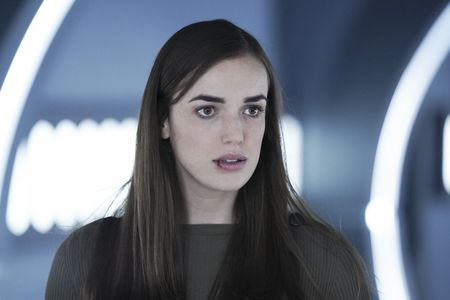


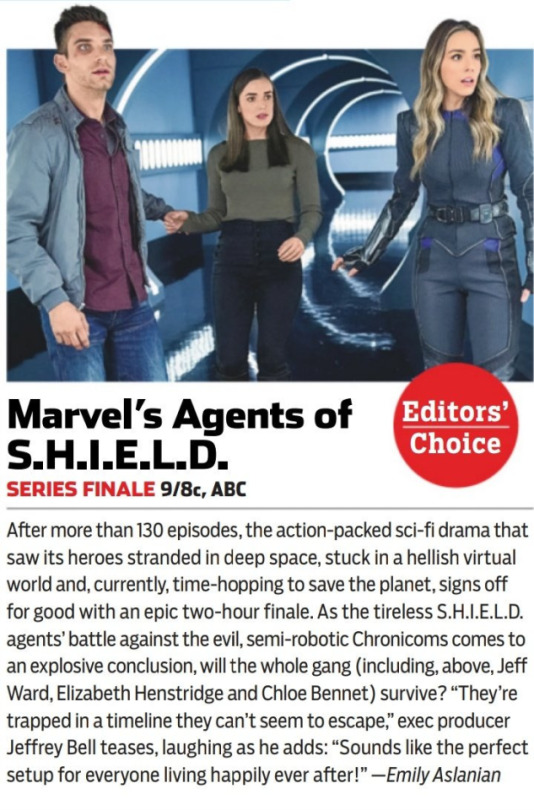
As I’ve said in previous asks I don’t think that is Fitz they are looking at, if so I think Deke would be more in the thank goodness Bobo is finally here face vs a wtf face. And now thanks to the Leak I can pretty much confirm that it was....

Kora.
Who looks to have a bone to pick with Daisy and really we are trying to escape here so if Sousa and Mack could just come and knock her out real quick or if Daisy can just get this over with fast we’ll be on our way. However, I am a bit on the fence if May was able to get through to her and nothing would set up Nathaniel killing her like Kora betraying him and helping his rival Daisy and his meal tickets to Fitz get away.


I shall pause for the collective aww of Jemma sleeping on her very protective grandson’s shoulder. They’ve been through a lot and I love how we’ve been able to see their relationship grow over the season. Its everything I’ve been wanting since the second we learned who he was.
Clearly they have been taken onto one of the Chronicoms ships, either for them to continue to interrogate, as bait for Fitz knowing that he will tear the Universe for Jemma Simmons, or as hostages to use against Shield. The second picture to me looks like almost a more candid photo that could have been taken between sets but it could just be some more lovely bonding.

Daisy to the rescue! However, I get some major bad vibes from this here. Jemma looks almost afraid of Daisy (who likely quaked her way in) and doesn’t seem to know who she is. Meaning Diana had to block a lot of other people when she blocked Fitz out. Hopefully I’m wrong here and Jemma is just upset because Daisy is freaking out about the whole “Who is Fitz?” thing too.

And we are making for the exits! Hazzah bearing in mind we run into Kora shortly after this.

TV Guide Pic Explained above.

Jemma is simmonsing, trying to explain something. Perhaps about Diana, perhaps what she remembers about the plan and something they have to do while on said Chronicom ship. Really these are shots in the dark. The blue lights could mean the Chronicom ships are about do do something or its an early state of oh look trespassers. We do see the lights red in the Promo with Mack.


HELLO MORE WE HAD TIME FLASHBACKS!
And we can add another theory hit to the list! Looks like Fitz is using the Framework and I could be in the minority but I’m glad to see it. It was so heartbreaking in Season 4 to see something he built to protect Jemma and his friends twisted into a hellish nightmare prison. I am more than thrilled that he looks to have been able to put it to good use here and is either using it to keep an eye on the Chronicoms, which him in “Framework Mode” would leave him absolutely exposed. Or he’s using it as a way to build the tech faster. My guess is here is where the realize they’ve found a way to spy on the Chronicoms, they are testing something, or had some other ah ha moment.
Also worth noting is a pregnant Jemma there in the background, complete with a baby bump.

Fitzsimmons in the cock pit of the Zephy. Jemma looks tired, man I feel you girl, but Fitz looks oh so hopeful.


I mean.
I’m just.
I know I said I would die on that hill and have been for over a year now. But to see it, actually see it coming is still super overwhelming in a way.
But there she is! SECRET CHILD CONFIRMED!!!!!!!
Working and playing alongside her parents as they continue to prep for the final mission. Also happy to see Jemma’s frown turn upside down by her little ray of sunshine there.

I don’t know what this thing is, I have my theory that I’ll go into below, but whatever it is gong to be insanely important. Not only that Jemma is the one who is going to have to assemble and activate the dang thing.

Hence the practicing, even while blindfolded, working it into her muscle memory. Because Jemma Simmons excels at preparation.
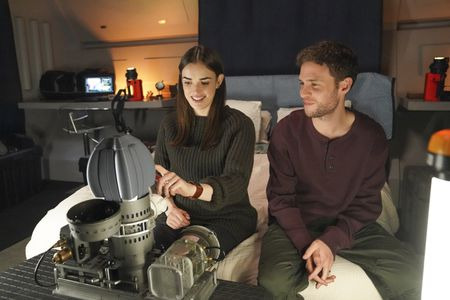
My guess is this is where Fitzsimmons explain how it works to us. I’m going with this sucker is how the frack we get Fitz back from wherever the crap he is. And you’ll see why below after he’s made his Grand Entrance.

And could explain her look of concern here. Concern she won’t get it right when the time comes. I also find it odd we have almost different variations of the same scene here or if its a Fitz wakes up and sees she’s concerned.

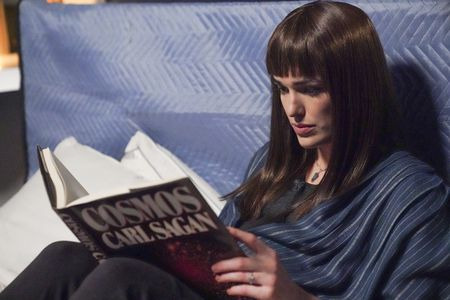
The we thought Inescapable was straight out of fan fic....well the finale leak says hold my beer. Jemma doing some light reading about the cosmos and taking notes even has mean leaning to them going with a more celestial name to speak to the “one of these days we’ll find something magnificent out in space” quote from Season 3 that came as they offically became cannon.
And then Fitz shows up with Tea, so this could be when we learn their daughters name or Jemma has figured something out to do with the Chronicoms and space and timey whimey stuff. I am rooting for option A.

I’ll take Fitz Kool Aid Manning in for $1000

And for like 10 seconds after he lands he runs the risk of being shot and/or quaked into next Tuesday. Also LOVE the parallel to Deke’s helmet and first appearance.

That glowy ball thing there looks very similar to the device that Jemma was working with in the earlier pics. So hence its the Fitz summoning device.
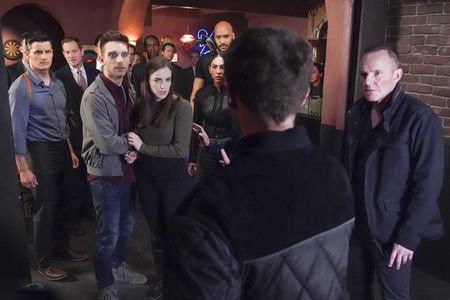
I’m calling this one with Jemma clinging to Deke here as confirmation that Diana is still in full force and she has no idea who Fitz is. May’s hand up there in the middle could be her warning him of Jemma’s fear or May letting Jemma know he means her no harm.
Also Enver wins the pose off for this pic.


Collective team surprise at Fitz once again appearing impossibly out of no where.
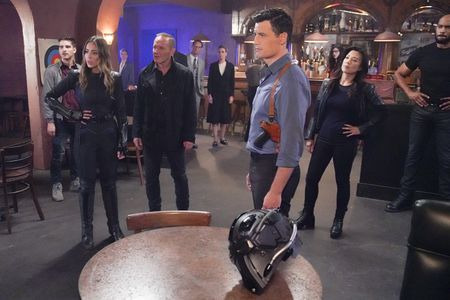
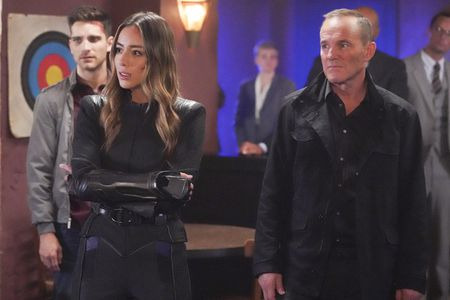
Based on the WTF looks on pretty much everyone’s faces I’m calling this Fitzsimmons Fitzsimmonsing what the heck the next step is how they they’ve unlocked Fitz as a playable character. And bonus shock that they had a Secret Kid all stashed away all this time too.
I also had a few asked about the helmet there on the table. If the Framework is how Fitzsimmons were able to hack into the Chronicoms systems (turn about is fair play) then I think that helmet on the table was how Fitz was hooked up to it. And it definitely looks different than the one he made his grand entrance in wearing. Jemma activating the device could be what pulled him out and to her. Jemma was literally the ONLY key to getting at Fitz.

And for the Dousy fans out there! Sousa is kinda digging the crazy plan Fitzsimmons just laid out and are they in the Playground or Koenig Bar? Either one I appreciate its not blown up.
Okay there you guys go. I left out just a few of the pics that were super close ups or seemed to be more of BTS than from the shot kind of thing. Have to say it was a very nice surprise to get to do this one more time and on a theory that has been so near and dear to my heart.
#aos spoilers#aos finale spoilers#secret child is real#fitzsimmons#dousy#i'm so happy#and tired#and oh so happy#but also really tired#I think I've earned a bath and retail therapy
200 notes
·
View notes
Text
Codename Cupid: Chapter 22
Previous: The Final Notice
Pairing: Jeon Jungkook x OFC
Genre: Secret AgentAU, Government AgentAU
Rating: PG15
Word Count: 3.2K
Warnings: Swearing, Mentions of Sex, Mentions of Abortion
Summary: Black Panther, Cricket and OT7 finally meet.

Cricket & OT7: Return to Sender
Present Day
“Why are you following me?” I ask, hands bound together, eyes blindfolded. The car has stopped, and whomever was driving has exited the vehicle in favor of opening my door and yanking me out. It’s silent, apart from my breathing and unavoidably stalky footsteps. I’ve never been able to walk on eggshells, perhaps it was my mother’s direction that stomping on them was far more impactful, that has led me to wear through every heel of every shoe I’ve ever owned. Now, it isn’t my saving grace, rather a rude awakening that I must sound like an ogre to the people who live below me.
I arrived at the designated location, Jungkook trailing behind me. He refused to let me go alone but did compromise and stay in the damn car. He could see me, and I could see him. I was waiting for no more than a minute before promptly kidnapped. Not even chloroformed, just fucking grabbed and taken. Kidnapped, blindfolded and bound. Bound! Some knot a boy scout or aspiring I’m tossed in the back of a car, which, is how I’ve found myself willfully dragging my heels as they ever so gracefully force me in their desired direction.
“Black Panther, why are you following us?” The voice asks. I know that voice, I’ve heard it before, I’ve heard that code name. Had it been referring to me this entire time?
“Us?” I ask again, tossing my voice to see if it reverberates against anything, any sign that furniture or people are nearby.
The man guiding me stops abruptly and peels off my blindfold. Empty spaces are their own kind of hell, and this is no exception. The panic of darkness arises as I close and open my eyes, ensuring they’re really open and not a trick of the mystery man’s charms. I jump softly as seven lights are dropped, one in each spot in front of me, a delicate row of halos waiting to be adorned. Five men step out of the shadows, the one holding me in place making number six. Their pressed suits, cut from the finest cloth, each distinct in their pattern and style, garnish their bodies. As if on cue they cross their arms over their chests and glare openly at me.
“Kim Namjoon, Kim Seokjin, Min Yoongi, Jung Hoseok, Park Jimin, Kim Taehyung,” I rattle off, each man nodding as I speak their names.
I know them all, tailed them, surveyed their homes, run into them at the grocery story and Mexican restaurants. All except fucking min Yoongi, but I know them. I know these men. I’ve spent the better part of what, two years, trying to understand them, trying to figure out how they’re related, and here they are. There’s space for another, and it takes me a minute to realize who it is that occupies that is supposed to occupy that spot.
“There’s only six of you… where’s -
“Jeon Jungkook,” His voice comes from behind me, goosebumps running up my spine as the heel of his boots hits the concrete. My body is awash in shock, anger, comfort and hope. My Jungkook. My, I have to come home to him, my north star, my sunshine on a cloudy day, my Bunny.
I was fucking right all along, wasn’t I?
“Welcome to the party.” Seokjin says.
“Is this where you tell me that Euna is Hans Gruber and somehow I’m Sergeant Powell?” I question, by tone delicate against their stone expressions.
“If anything, you’re Harry Ellis,” Yoongi says.
“That’s so rude,” I retort. “At least let me be Holly Gennaro.”
“Then who are we, McClane?” Yoongi snorts, the absurdity of my statement causing a brief moment of joy. “Bunny wishes.”
“You’re interrupting our mission,” Namjoon states, pulling my attention to him. His broad shoulders give way to a tapered waist, round golden spectacles are situated against his face, and his jaw is locked tight.
“Me? How the fuck – oh,” My eyes move towards the bulletin board against the far wall, in quintessential fashion there are pictures, string, maps and enough thumbtacks to secure the list of vets from the Vietnam Memorial. I can’t read it, but I can see it. “You guys aren’t the bad guys.”
“No, we’re not,” Namjoon says.
“The Lee family is,” Taehyung says. It’s odd seeing him this quiet and stoic, after all he’s the hottest librarian in the damn county. He comes alive within the confines of his books and stories, he comes alive. He has voices and characters and gestures to match each. Looking at him now, it’s wild to imagine him doing a full interpretive reading of The Very Hungry Caterpillar, or his most famed retelling, Peter and the Starcatcher, when he’s glowering down at me.
“They are poison, seeking revenge on anyone who has worked on cases to bring them down,” Hoseok says.
“So, you all, how did she find you?” My mind is moving too fast for me to form coherent sentences.
“Cupid didn’t find us,” Jimin tells me, eyes still boring holes into mine.
“You did,” Namjoon answers.
“I did?” I ask, eyes wide.
“Mm, your little stunts, your run ins, your photos. She gave you our real names and you-
“Gave her our locations,” Taehyung finishes the sentence, eyes still trained on me.
“You left the notes, and the photo for Euna to find,”
“Yes, but unlike you, our move was intentional,” Yoongi says.
“Codename Cupid needed to know there were higher stakes at play,” Hoseok tells me.
“How was I supposed to know this was some larger conspiracy?” I demand, temper rising.
“Did you not receive notes?” Hoseok asks, by his expression I can tell that he’s responsible for the code breakers that have arrived at my apartment and office over the last nine months. “Strange packages arriving out of nowhere, sent to your office, on the driver’s seat?” Hoseok pushes.
“Yeah, but I’ve had some really sketchy clients in the past, though none of them preferred an ABA rhyme scheme,” I retort.
“Do you know how we found you?” Yoongi snaps.
“Yes?” I ask, genuinely confused, “Google my name and my office pops up. Anyone can find me.”
“Your tactics are fucking bush league, Black Panther. They’re embarrassing,” Yoongi tells me.
“You’re a P.I., not a cop, not an agent, you’re not in the Bureau, yet you’re overstepping into situations that you have no grounds being involved in. You are fucking playing with fire and we were about to be burned if we hadn’t –
“Seokjin,” Namjoon’s voice is biting, harsh, a belt to the back as it cracks in the hot air.
“She needs to know,” Taehyung responds for his hyung.
“Cupid has been lying to you for months, leading you on, paying you over your asking to track us down for what? A few lies you don’t even believe to be true?” Jimin asks.
“We embezzled funds from their charity organization? We reported her family to the IRS?” Taehyung asks.
“We stole jewelry from her famed collection to sell on the black market?” Seokjin adds.
“We’re trafficking high quality cocaine from Colombia into the upper echelon of society?” Jimin rattles off more lies.
“We fucked her, broke her heart, and god – the worst one – we made her abort our child?” Yoongi spits on the floor, disgust flowing through his saliva like blood in the Nile.
I stare at them, mouth agape as they recite words I’ve only spoken to one person. My vision becomes blurry as I try to breathe, in through my nose, out through my mouth, but my heart is pounding in my ears and I can’t breathe. The tears always sting before they fall, and my eyes land on him, tall, blonde hair, clear framed glasses, doe eyes.
“You told them?” I whisper, the end of my sentence curling up into itself as the first tears start to fall.
“I had to,” A whisper, feet frozen to the ground as he refuses to make eye contact with me.
“You were using me?” I ask. “Look at me.”
“I wasn’t using you,” He says, soft eyes meeting mine, the fire scorching the earth.
“So how do they know?” I spit, the little droplets doing nothing to squelch the flames.
“I had –
“You told them information that I shared with you, in confidence, in my fucking bed, in my fucking homeJungkook!” I yell.
“Cricket, can we talk about –
“How dare you use my nickname to get me to calm down, I’m not a fucking child,” the sound of my cries reverberates against the warehouse, echoing violently.
“I can exp-
“There isn’t time for you to sort out your fuck up, Jeon. We have real problems to discuss,” Yoongi snaps. I can feel the tears dripping from my chin, falling to the concrete beneath my feet. The adrenaline pumping through my body as both a reaction to fear and a telltale sign that I’ve been embarrassed beyond repair. Not just embarrassed, eviscerated, betrayed. An hour ago, hadn’t I been deeply in love, terrified I wouldn’t return home to him?
“What do you want from me?” I ask. Jimin hands me a tissue, which I am grateful for as I attempt to gently blot my soaked skin. My mascara, never waterproof, comes off my eyes in dark splotches. How poetic.
“Come, have a seat, Jungkook, get her a water,” Namjoon instructs. He strides towards the bulletin board and pressing a few buttons, the board sinks in the floor to reveal a hallway. The gasp that echoes through the warehouse is audible, and louder than I intend.
“Sorry,” I say, feet guiding me past Jungkook, towards the corridor. There are no pictures on the walls, no signs that this space is used by anyone. The industrial style gives way to a door, bulletproof.
Namjoon pauses, inserting his thumb into a scanner that gives way to a retina display, where he gently places his chin against the base. The machine works quickly before giving him entrance. I watch, amazed. Who knew in the 21stcentury that covert ops and me, a lonely P.I., would intersect?
“This is, headquarters,” Seokjin says. He takes a seat at the long table in front of us and points to the chair next to Taehyung. I sit quickly, my eyes adjusting to the surprisingly bright space.
“Oh my god the view,” I say, composure slightly recovered as I take in the expanse of greenery.
“Yeah, benefit of being in the middle of nowhere,” Yoongi says.
“Read your file,” Namjoon instructs.
The file in front of me, manilla of course, is packed. “Why paper copies?”
“Easier to burn,” Yoongi mutters. He’s taken out his computer and is busy typing away, no doubt pulling up a list of my infractions. Undoubtedly fucking an undercover operative is number one, though falling in love is objectively far worse than sex.
Jungkook brings me a water and deftly cuts the zip ties around my wrist. His hand moves to sooth the indentation and redness from their grip, but I pull them away before his thumbs graze over the skin. Out of the corner of my eye I watch him retreat to his seat at the end of the table.
“If you’re the top of the line, 007 should be shaking in his oxfords, can’t you encrypt it?” I ask.
“Your encryption is only as good as your worst coder. We can’t take that chance,” Namjoon tells me.
“First, I don’t think that’s the saying. Second, the government, who I’m assuming you work for, Interpol, MI6, etc. all use computer systems,” I counter.
“Do you remember the election of 2016?” Yoongi retorts.
“Point taken,” I nod. Of course, Russia. No one was ever safe. “But can’t you blame a lot of that on Zuckerberg and the higher ups at Twitter?”
“Read your file,” Namjoon instructs again.
I open it to find a rather aggressive breakdown of my work as a PI, both items that were on the internet and ones that only top-level government agents could have accessed, that is, unless the NSA has been tapping my phones. Details of my family life, my past relationships, my driving record, it was all here.
“Why isn’t Jungkook on the list of romantic partners?” I ask, eyes looking from Seokjin to Namjoon.
“Are you in love?” Namjoon asks.
I don’t wait for a response from Jungkook, or to find the courage to say the simple three lettered word, yes. Instead, I busy myself by clearing my throat and loudly moving the pages about my life to a separate pile. Underneath is all my evidence, print outs of my documents, surveillance photos of me working. I stare at them, horrified.
“How long have you been tailing me?” I question.
“How long have you been working with Euna?” Taehyung asks.
“Sixteen months,” I reply.
“Ten months.” Taehyung answers.
“You hacked my computer? Is that legal?” I inquire, knowing full well that it isn’t.
“I can tell that you don’t understand who you’re dealing with, so let me put it this way. We’re the ones who knock. We’re the ones who cause dignitaries, presidents, whole countries to quake in their boots. It’s us.” Namjoon’s voice is calm within the storm, its resolute and baritone and every word that he utters is meaningful, impactful. He means what he says, and he fucking says what he means. In every interaction I’ve had with him, which frankly have been maybe more than he realizes, he’s been measured in his speech, only speaking when he has something worth saying. He is patient with himself, kind to others, except for today, when he clearly does not want to deal with me.
“How very Heisenberg of you,” I roll my eyes.
“You don’t want to be Jane,” Namjoon urges.
“Okay first of all, in a Breaking Bad scenario, I’m clearly Jesse. Second of all, Krysten Ritter has had a very lovely career. Finally, this cannot be overlooked or underestimated, I’m Veronica Mars, bitch.”
“Read. Your. File.” Namjoon’s teeth are clenched, his fist resting on the table, his patience going.
I glance at Yoongi who is sniggering, Seokjin who is making eyes at Jungkook, and Jimin who is busy doodling along the margins of his file. These glimpses, these little hints at the weight of their souls, these are the men I’ve been following for nearly two years.
It’s in staring at the remnants of my evidence that it hits me. “Jungkook gave you these photos.”
“Yes,” Seokjin answers.
“Everything you told me was a lie,” I say, eyes burning holes into the stolen images of my work.
“Crick- Y/N, that’s not true,”
“I knew you were connected, that day in the dog park, I knew,” I should’ve trusted my instincts, though they told me to trust him, maybe I should’ve run.
“I didn’t lie, Cricket, I -
“Look, I’ll work with you, whoever you are, but I’m not working with Jungkook,” I look at Namjoon.
“That’s not an option, Black Panther,”
“How did I get that nickname?”
“Can you focus for ten minutes? Read your damn file so we can discuss the next course of action before you have to go meet Codename Cupid for your weekly meeting,” Namjoon bites.
“Fine, do I have to go to that meeting if you’re, doing whatever you’re doing?” I question. “Seems a bit redundant.”
“If you don’t meet with Cupid, she will know we found her, and our decade of work is completely useless.” Seokjin says, stepping in to mitigate the anger erupting from Namjoon.
“What am I supposed to say to her? She knows too much already,”
“She doesn’t know what she knows,” Yoongi answers. “Looking through her emails and texts, it’s clear that her family wants the seven of us dead for espionage, and for attempting to bring them down. All Cupid knows is that you found us, which she assumes is a fatal flaw in our plan, though she has yet to understand the plan at all.”
“It’s completely intentional,” Hoseok adds. “Cupid only knows that we either worked for her company or dated her or a sibling. She knows our fictitious careers and lives but has no clue about who we truly are.”
“Her brother, Dae-Seong, Codename Archer, is the one who wants us gone, eviscerated, eradicated. He’s the one driving this whole thing. Archer’s convinced Cupid that vengeance will solve her romantic woes,” Jimin tells me.
“But what about Jun-Seo? You left him the night of your engagement party, and Kwan-Min, you went on a few dates… Couldn’t this be about them?”
“Codenames Bow and Arrow are less of a threat than Cupid and Archer,” Taehyung answers.
“Cupid has been kept in the dark for the past, fifteen years, in regard to their business. The dark dealings of her company reside solely with her siblings and their parents. We want them,” Namjoon finishes.
“Why not use Euna, sorry, Cupid, as the patsy?” I ask.
“Who will run their company?” Yoongi asks.
“Someone else?”
“There’s too much evidence, nearly the entire company is dirty,” Jimin tells me.
“So, you’ve been spying on them from the inside?” I question.
“Sort of,”
“It’s Nixon, Watergate extreme?” I ask.
“What does Cupid know, and when did she know it?” Yoongi answers, his annoyance completely dissipating at my Watergate mention.
“Why do you think she’ll believe me? She doesn’t have much faith in me as of late,” I question, the lilt of insecurity in my voice. Jungkook glances at me, eyes soft at the familiar tone, he tries to offer a smile, at least, it looks like he’s trying.
“Yeah, because you fucked Jungkook and she found out. Before that though, she couldn’t sing your praises enough,” Namjoon’s calmed down, his frustration settling like sediment at the bottom of a pot. Adding an eighth person to the group was always going to shift the balance, move the power around and rattle nerves. But me? I’m burning it down. Though I can’t completely be to blame - Jungkook is also at fault.
“Fine. What do I say to her?”
“Haven’t we gone over this before? Lie,” Yoongi says.
“Yoongi, if you’re going to be an ass, can you please direct it at someone else?” I snap.
“Feisty,” He nods approvingly.
“Black Panther, you have notes in your file about what we need from you,” Namjoon instructs.
“You want me to end my relationship with her?” I question.
“Yes,”
“What about –
“Either you end it first, creating an enemy, or she ends it with you which will not be helpful for us,”
“I just,” I look at them, eyes finally glancing to Jungkook. He looks exhausted, and sad, so sad, his irises choppy waves searching for harbor. “Do I have a choice?”
“No,” Namjoon answers, but Jungkook’s eyes tell me exactly what I need to know. I don’t have a choice, and somewhere along the line, he stopped having one too.
“Fine, tell me what to do,” I flip to the page in my file, eyes scanning the words, mind no longer full of Jungkook my boyfriend, but of Jungkook, Operative, member of OT7. This is a job, a job that seemingly could make or destroy my career. I don’t have time or the emotional space to navigate his crashing midnight eyes. All I have now is focus, drive, determination, and hints of stubbornness. This is the same drive that in a weird twist of fate, has led me to this very conference room, with these seven mysterious men.
I cannot fuck it up.
I will not get a second chance.
Next: Black Panther Meets Codename Cupid
#clubjimin#houseofddaeng#kim seokjin#kim namjoon#kim namjoon / rm#min yoongi#min Yoongi / suga#jung hoseok#Jung Hoseok / j hope#park jimin#kim taehyung / v#kim taehyung#jeon jungkook#jungkook fanfic#jungkook x reader#Jeon Jungkook x reader#secret agent au#BTS agent#secret agent au#BTS fanfic#BTS fan fic#BTS writing#codename cupid#code name#love#relationship
14 notes
·
View notes
Text
The best new board games for holiday family fun

Update your holiday fun with the season’s newest family board games. (Photo: Getty Images)
If “quality time” with your family is on your to-do list this holiday season, there’s no better way to make it happen than by pulling a board game off the shelf.
Our suggestion: Shop from our list below to find games to give everyone on your list. Once the unwrapping is over, pass around the eggnog and hot chocolate, and settle down for a family game night for the ages — and for all the ages in your family.
Here are our favorite new games for family game night. All were released within the last year, and all are guaranteed to please both the young and the young at heart.
The editors at Yahoo Lifestyle are committed to finding you the best products at the best prices. At times, we may receive a share from purchases made via links on this page.

Trivial Pursuit 40th Anniversary Ruby Edition. (Photo: Amazon)
Trivial Pursuit 40th Anniversary Edition Ruby Edition
We love it when an iconic game gets a contemporary update. Case in point: this premium new release of Trivial Pursuit. It includes questions from six categories — geography, entertainment, history, arts and literature, science and technology, and sports and leisure — plus the Ruby deck, featuring key questions from the past 40 years. If you’re a family full of trivia buffs, brainiacs or plain old know-it-alls, this one’s for you. Best for ages 16 and up.
Shop it: $19 (was $40), walmart.com

Don’t Step in It. (Photo: J.C. Penney)
Don’t Step in It
If your family delights in potty humor (and let’s face it, whose doesn’t?), urine for a ton of fun with this bestselling game. Use the molds and compound provided to make your own piles of pretend doggie doo-doo; then try not to step in the poop as you walk along the mat while wearing a blindfold. Don’t be a party pooper: We guarantee this No. 2 game on our list will have everyone laughing. (As will the even newer, rainbow-colored Unicorn Edition.) Best for ages 4 and up.
Shop it: $20, jcpenney.com

Unstable Unicorns. (Photo: Target)
Unstable Unicorns
Speaking of everyone’s favorite mythical creature, one of Kickstarter’s most-backed projects of all time is now available for sale everywhere. Often described as the “next” Exploding Kittens, the idea of this strategic card game is to build an army of unicorns while you “betray your friends — in a good way.” Unstable Unicorns gets bonus points for the hilarious phrases printed on many of its cards and the adorable Pokemon-style artwork. Best for ages 14 and up.
Shop it: $21, target.com

Mindware Double Spot Strategy Game. (Photo: Oriental Trading Company)
Mindware Double Spot Strategy Game
Don’t spike the eggnog if you’re planning to win at this new game. Players work to complete the same patterns at the same time while taking risks in an effort to outwit their opponents. Double Spot Strategy may not be easy to win, but it’s easy to learn — so it’s a great gift for the whole crew to learn on the spot as they pop in and out between other family activities. Best for ages 6 and up.
Shop it: $25, mindware.com

So Cards: A Collection of Questions for Deeper Discussions. (Photo: Amazon)
So Cards: A Collection of Questions for Deeper Discussions
We love a conversation starter, and this new game goes straight for the big ones. Like, “If you could witness one key moment in history, what would you choose?” Promising 52 cards and unlimited conversation, the lightweight deck is easy to toss in your bag and play anywhere. While not a game in the traditional sense, this Kickstarter-funded concept is a gift to any family wanting to forge more meaningful connections. Best for ages 12 and up.
Shop it: $15, amazon.com

The Incredibles: Save the Day. (Photo: Barnes & Noble)
The Incredibles: Save the Day
Play as your favorite member of the Parr family — Violet, Elastigirl, Dash or Mr. Incredible — as you work together to save Jack-Jack, who gets teleported throughout the city. Along the way you’ll have to collaborate to solve problems as they arise throughout Metroville, with each of you using your own skills and abilities to the advantage of the group. This cooperative game is easy to learn and fun for movie fans of all ages. Best for ages 6 and up.
Shop it: $20, barnesandnoble.com

Pie Face Cannon game. (Photo: Walmart)
Pie Face Cannon Game
If most of your video footage features Grandma getting a face full of whipped cream, you’ll love the next-level version of this famous game. In the new Pie Face Cannon Game, one player rests her chin behind the face mask, while the other player aims the cannon and launches a dollop of whipped cream. The player behind the mask can try to avoid getting “pie-faced” by using the blocking hand. Players earn points by either “pieing” their opponents or successfully blocking the “flying pie.” Good for hours of hilarity, especially among the little ones. Best for ages 5 and up.
Shop it: $10 (was $25), walmart.com

Wham-O Stay ‘N Play Maze Craze. (Photo: Walmart)
Wham-O Stay ‘N Play Maze Craze
A dynamic new version of classic wooden marble runs, Maze Craze invites players to create their own runs using a plastic pegboard, pegs, and rubber bands. The balls must go through the maze to the holes of the corresponding color before the timer runs out. Roll the balls by standing up, holding the lightweight board, and maneuvering just so. Take the compact game anywhere — even in your suitcase for a family trip. Best for ages 8 and up.
Shop it: $25, amazon.com

Kitty Bitty board game. (Photo: Walmart)
Kitty Bitty
In this cute and tactile game, players encourage the playful kitties to jump, bat the yarn balls around and race to the basket without catching a look from the watchful eyes of the mommy cats. A fun game to build visual perception and memory, Kitty Bitty is a sweet way to include your youngest family members while keeping the grown-ups entertained. Best for ages 4 and up.
Shop it: $31, walmart.com

Wonder Forge Disney Villainous board game. (Photo: Target)
Villainous
Strategic gamers, Disney fans and everyone else in your family will surely be charmed by this easy-to-learn yet totally one-of-a-kind game. Pick your Disney villain from among the most infamous of all time — Maleficent, Jafar, Ursula, Captain Hook, Queen of Hearts, and Prince John; then work within your own story as you aim to reach your unique objectives while thwarting your enemies with curses, traps and more. Best for ages 10 and up.
Shop it: $32 (was $35), target.com
Read more from Yahoo Lifestyle:
• 10 gifts your grandparents will love to receive this Christmas • The best gift ideas for the chef in your life, starting at $4 • Merry and bright: Add some sparkle to your home for the holidays
Follow us on Instagram, Facebook and Twitter for nonstop inspiration delivered fresh to your feed, every day.
#_revsp:wp.yahoo.style.us#_author:Meredith Barnett#yahoo shopping#holidays#board game#family gifts#holidays 2018#_uuid:33384a07-93a7-3cc9-b280-91e0486b2f4d#_lmsid:a0Vd000000AE7lXEAT#shopping
0 notes
Text
How to Be Creative (Ep. 354)
Vincent van Gogh is often characterized as a tortured artist. Among the mental disorders scholars diagnose him with: manic depression, schizophrenia, and epilepsy. (Photo: Dean Mouhtaropoulos/Getty)
Our latest Freakonomics Radio episode is called “How to Be Creative.” (You can subscribe to the podcast at Apple Podcasts, Stitcher, or elsewhere, get the RSS feed, or listen via the media player above.)
There are thousands of books on the subject, but what do we actually know about creativity? In this new series, we talk to the researchers who study it as well as artists, inventors, and pathbreakers who live it every day: Ai Weiwei, James Dyson, Elvis Costello, Jennifer Egan, Rosanne Cash, Wynton Marsalis, Maira Kalman, and more. (Ep. 1 of the “How to Be Creative” series.)
Below is a transcript of the episode, modified for your reading pleasure. For more information on the people and ideas in the episode, see the links at the bottom of this post.
* * *
What do you think when you hear the word “creativity”? Truth be told, creativity is having a bit of a moment. There are thousands of books on the subject, many written in the past decade. It’s become a corporate buzzword, right up there with “innovation” and “disruption.” It’s at the center of a whole lifestyle movement: online classes and Facebook groups and real-life meetups. There are creativity coaches, of course, and gurus, offering to rearrange your life to add more creative spice. So we here at Freakonomics Radio got to thinking: with so many people spending so much time and money and energy in pursuit of this thing called “creativity” — well, we wondered if there’s anything systematic to be learned about it? What if we started by simply defining the term. We asked a bunch of academics who study creativity, as well as some artists, musicians, scientists, and inventors: how do you define creativity?
Charlan NEMETH: You know, it’s actually harder than one might think.
Pat BROWN: Well, people use that word in lots of different ways to mean lots of different things.
Saul PERLMUTTER: There’s a huge amount of what goes under the heading of “creativity” that just has to do with a willingness to stick to a problem and a pleasure in it.
John HODGMAN: So, starting with nothing, having an idea, letting the idea pull you forward, getting it down, making it right.
Pat BROWN: “Okay, bingo, this is how we’re going to do it.”
Teresa AMABILE: It can’t just be different for the sake of being different, because that’s the definition of madness, I guess.
Teresa Amabile is a psychologist and a professor emerita at the Harvard Business School. She’s spent her career studying creativity, particularly in education and work settings. But I asked her: how is it even possible to empirically study something as diffuse as creativity?
AMABILE: Many people have the sense that it should not be studied scientifically, that you should not try to apply science and objective thinking to the magic of creativity, that it’s somehow in the spiritual realm. As you might guess, I don’t take that approach. I think that it can be studied scientifically without destroying the excitement and the sense of magic about creativity.
For economists, the concern hasn’t been about preserving the magic of creativity; they generally avoid the topic because it seems so touchy-feely.
David GALENSON: There’s sort of two questions: why do economists care? And the answer is economists really haven’t cared about creativity.
David Galenson is an economist at the University of Chicago. He does care: his central research interest is the life cycles of human creativity.
GALENSON: Why should they care? The single-most important problem for the discipline of economics is economic growth. Why are some countries rich and others poor? And virtually all economists agree that the single-most important source of economic growth in the long run, what really makes a country rich, is technological change. Well, technological change is just a lot of people making discoveries. So, it would seem to be a very big question, how do people make innovations?
* * *
Among the scholars who study creativity, there is no real consensus on who has it or even exactly what it is.
Charlan NEMETH: I was just looking recently and reminded of that old fable that if you have people blindfolded, looking at an elephant…
Charlan Nemeth is a psychology professor at the University of California, Berkeley who studies entrepreneurs and creative scientists.
NEMETH: …and one of them is looking at the tail, he thinks it’s a snail he’s touching. And if you have someone approaching it from the side, he thinks it’s a wall. And it’s just a reminder, in a way, that what you focus on, to some extent, determines how you think creativity works. In many ways, it’s a very difficult, and still to some extent mysterious phenomenon. So if you get somebody studying it in business innovation, for example, separate from studying Nobel laureates, or separate from looking at it in experimental tasks, for example, in a lab. So it’s very hard to compare those because they use different definitions of the end product as being creative or not.
But you’ve got to start somewhere. And that’s why Teresa Amabile starts with a basic definition that’s accepted within the field of psychology.
AMABILE: We identify creativity as essentially novelty that works. It has to be somehow feasible, workable, valuable, appropriate to a goal. And it gets a little a squidgy when we’re talking about the arts. What does “appropriate” or “valuable” mean in the arts? But I think even there, pure novelty just for the sake of novelty isn’t really going to do it. It has to be somehow expressive of something that the artist was trying to convey or evocative of a response that the artist was trying to evoke.
“Novelty that works.” I think that’s a great starting point. What if we run that definition past a creative type — Michael Bierut for instance. Bierut is a world-renowned, much-awarded graphic designer: you’ve seen his logos; his work is in museums. How does he like defining creativity as “novelty that works”?
Michael BIERUT: Yeah. I mean there’s this famous formulation by the 20th century designer Raymond Loewy who designed the Lucky Strike package and the livery of Air Force One among other things. He used — he had this four-letter formulation: M.A.Y.A.: Most Advanced Yet Acceptable. And it was based on his theory that everyone has these two impulses. And one is the desire for regularity and comfort, and the other one is the quest for surprise and novelty, right? If you have too much regularity and comfort, you get bored. If you get too much surprise and novelty, you get overexcited wired and distracted and exhausted. It’s the idea that it’s novelty with a purpose — that purpose is the element that actually is about expectation and expectations fulfilled. And the novelty part of it is the idea that those expectations might be fulfilled in a way that you haven’t seen before.
It turns out that psychologists have come up with a way to test our ability to produce “novelty that works.” Charlan Nemeth again:
NEMETH: It’s called the “Uses Test.” Basically if I ask you to give me all the uses you can for a brick, you could say that you could build a house, you could build a factory, and you could build a road. And that’d be three ideas, but they’re all basically building. A more creative answer would be that you could build a house, you could use it as a platform to hold a cup of coffee, you could use it as a missile to throw through someone’s window as protest. And other tests of creativity all have that element to it: they see if the mind tends to go wide and down different routes and that it can even make connections through circuitous ways of getting there.
That’s one way to measure someone’s degree of creative thinking. But how about studying creativity the other way around — starting with people that everyone agrees are wildly creative? That’s the route chosen by Dean Simonton. He is a professor emeritus of psychology at University of California, Davis.
Dean SIMONTON: I wanted to study creativity and genius and leadership, but I wanted to do it in a way that was different than what most psychologists did. Because most psychologists, they study, really, college undergraduates who happen to be taking a Psych 1 class. And they have to volunteer to participate. And those are not the people I wanted to study. And so I had to figure out a way of studying people like Michelangelo or Beethoven or Einstein when I couldn’t get them to come to my laboratory — particularly since most of them were deceased, which made it kind of awkward. So, I started developing various ways of studying genius at a distance, measuring their personality, measuring their intelligence, looking at their childhood and adolescence, the nature of their career.
Stephen J. DUBNER: Did you have a pretty smooth path through academia then, to become a Ph.D.?
SIMONTON: Oh no, I had a lot of times where I had to struggle. For example, when I decided I wanted to study real creators, and real geniuses, instead of college students, I had a hell of a time trying to put together a thesis committee. Because not everybody thought that that was even a legitimate form of doing psychological research.
DUBNER: Because why?
SIMONTON: Because at that time, and it is still the case — in fact, in many ways it’s even more true — the laboratory is considered to be the acme of science, having a lab in which you collect your data. And in the case of psychology, a lab means a place where, for the most part, you bring in college students to study. Something about 86 percent of all research in psychology is based on college undergraduates.
DUBNER: That’s a very very narrow cohort, not just age-wise but also background-wise and IQ-wise and all that, it’s pretty homogenous. What about just the fact that even good lab experiments, forget about all the bad ones, that it doesn’t really represent the real world well enough, especially in the realm of psychology, but also economics, I would say. Was that a concern for you as well, or no?
SIMONTON: Oh yeah, it was definitely. To me, there’s a distinction that is made between what’s called internal validity and external validity. And internal validity has to do with the power of making causal inferences from your research, and laboratory experiments are really really great in internal validity. But external validity is — does it really tell you anything about what’s happening in the real world? What often happens when you want to study something in the lab that is actually in the real world, you do a simulation. But you have no way of knowing whether or not that simulation actually represents what happens out there. For example, I wanted to find out what were the social, cultural circumstances that were responsible for why, in some periods you have golden ages with lots of geniuses, and other times you have dark ages, where it’s really hard to find anybody who even knows what they’re talking about. Right?
DUBNER: How do you do that in a lab?
SIMONTON: How do you do that? I wanted to look at the impact of war. I wanted to look at the impact of having role models in your field when you’re growing up. I wanted to look at the impact of the political system, whether you had a lot of independent states or whether it was a big one unified empire. And those are things you just can’t study in the laboratory. You can’t say, “Hey, imagine you’re growing up in the Middle Ages, and how creative do you feel?”
So how did Simonton go about studying this incredible range of factors?
SIMONTON: Well actually the story goes back to elementary school, believe it or not. When I was in kindergarten, my kindergarten teacher came to our house and told my parents — I came from a working-class background, in fact my dad didn’t graduate from high school. And they said, if you want your son to do well in school, you need a set of encyclopedias, World Book Encyclopedias, and that it would really help him. And these books are designed from K-12 and very useful for writing term papers, and all that kind of stuff.
DUBNER: Those were expensive. That was a big deal.
SIMONTON: Yeah. That was expensive. It was an amazing purchase for them to make. And I started browsing through them. And one thing that is characteristic of the World Book, is they have lots of pictures. And I saw lots of pictures of strange-looking people, people with beards, people with long hair, people of different ethnicities, periods, whatever. And I wondered, how did they get in that? How did they get their entry?
DUBNER: Ooooh, yeah.
SIMONTON: Why were they so important? And particularly since I realized my parents didn’t have entries, my elementary school teachers didn’t have entries, I was always curious about just how you become eminent enough to end up in an encyclopedia, or just have someone write a biography of you.
DUBNER: Was it — envy is not the word I’m looking for. Did you want to belong to that tribe, and you were trying to figure out how to get there? Or you were more curious about who were these people and where did they come from?
SIMONTON: Well, it was a combination. I wouldn’t say it was envy, but it was curiosity about how they got there, and could I be in that group? Do I have what it takes?
DUBNER: And what do you have to do to get it there?
SIMONTON: Yeah. And what do you have to do? What’s the process? And is it something that you can develop as well?
Simonton learned to pay attention to all the details in the biographies he was reading.
SIMONTON: And it would talk about where they came from. Sometimes it would mention their birth order. Sometimes it would talk about their education and maybe some of the struggles they went through, and then their career. And then histories also have a lot of information about what’s going on externally, whether or not there’s any wars going on, whether or not there was a dictatorship or a democratic government. There’s also information having to do with personality, like this person was introverted or this person was extroverted. We know, for example, that Newton had a lot of characteristics that suggest that he was a high-functioning autistic. And he was very, very introverted. And we can see that from his behavior, as well as having some paranoid psychosis attached.
DUBNER: So, let me ask you the really obvious question. When you study people like Michelangelo and Beethoven and Einstein, who, I think most people would agree, were pretty good at what they did, and maybe all the way up to creative genius. Obvious question, what did you discover about creativity and genius? I guess, what do they have in common?
SIMONTON: Well first of all, I have to say that artists and scientists are not equivalent as geniuses. But they also have things that they do share. They are all very intelligent in a general-intelligence way. Not necessarily in terms of taking an IQ test, but they’re very sharp. They love what they’re doing. They’re absolutely committed to doing what they’re doing. They want to spend their whole life discovering the nature of the universe, or creating incredible paintings on the ceiling, or whatever it happens to be, and they are willing to overcome all sorts of obstacles and all sorts of struggles.
Like Michelangelo and the agony and the ecstasy scenario: even though he was recognized very early as a genius, he had constant struggles. And he often had major projects terminated, like with Pope Julius II. And it’s not easy to be a genius. All of them, whether they’re scientists or whether they’re artists, have that tremendous drive and commitment and determination to keep on going, even when they’re failing and failing and failing.
At this point, you may be starting to think: well, what Simonton’s describing sounds an awful lot like what’s known as the 10,000-hour rule of excellence.
SIMONTON: In our research, we call it the 10-year rule. There’s a little arithmetic that makes them equivalent, 10,000 hours equals 10 years. But, in any case, that is absolutely unquestionable, that you have to establish an expertise and — you have to know what you’re doing. You have to have the tools of the trade. Now, sometimes people enter fields where there’s really not that much to learn because they’re brand-new fields. When Galileo, for example, invented his telescope and pointed to the skies and saw all these things that are not supposed to be there — there weren’t supposed to be mountains on the moon. There weren’t supposed to be moons circulating around Jupiter. There weren’t supposed to be spots on the sun, and so forth and so on. He was creating a domain from scratch. So, he didn’t have to spend ten years learning something that was already obsolete. He was inventing his own field.
DUBNER: So being first is always a good idea.
SIMONTON: Yeah, if you want to avoid all the hard work of studying, just be the first in a given domain.
* * *
This is the first episode in a new, recurring series about creativity — which, for empirically-minded people like us, is a notoriously squishy topic. The psychologist Teresa Amabile again:
AMABILE: So there are a few myths about creativity that are very popular.
So let’s at least clear up a few myths, shall we? First off, when most of us think about creativity, we focus on the arts — music and film, the visual arts, writing, and so on. Maybe you also think of a scientist or a researcher in the lab, thinking up experiments to test a new hypothesis. That’s all understandable, since these are people who make a living through their creativity. But Amabile thinks that view of creativity doesn’t go nearly far enough.
AMABILE: Creativity is possible in all realms of human activity. If we define creativity as doing something novel that works, that is valuable in some way, it’s absolutely possible in everything that humans do.
One of my favorite examples of creative thinking outside the arts is the story of John Snow, the English doctor who’s considered one of the pioneers of epidemiology. In mid-19th-century London, Snow was trying to identify the source of cholera outbreaks. Many doctors thought it was spread by “miasma,” or “bad air.” Snow thought it maybe had to do with germs in the water supply. Using maps, statistics, and common sense, Snow identified one pump whose contaminated water had caused nearly 200 deaths in a single outbreak of cholera. Over the ensuing centuries, Snow’s breakthrough would help save countless lives. And that strikes me as a deeply creative act.
Seth GORDON: Yeah, I think that’s right. That’s an example of profound creativity that isn’t artistic or artistic with a capital A.
That’s the filmmaker Seth Gordon. He grew up with two social scientists as parents; now he directs big Hollywood films and also makes lots of TV shows and smart documentaries.
GORDON: I think actually the most creative discipline I’ve ever witnessed in person is probably coding. Because you’re creating the language that you then employ to make something happen. That is profoundly creative. And whether that’s for making a game or whether that’s creating a program or whether that’s — I mean, in a way maybe the most creative thing I’m aware of in the last 10 or 15 years is the Stuxnet virus.
He’s referring to the computer virus, generally thought to be created by American and Israeli programmers, which in 2010 attacked Iran’s nuclear program.
GORDON: That thing is unbelievable, like what it was, what it did, and how it accomplished it. But I don’t think anyone would call that creative in any normal sense. It’s bad, right? But it’s making something that never existed before and tricked everyone for a very long time. It’s amazing.
Creating computer code that can shut down your enemy’s nuclear centrifuges — yes, I can see how that’s creative. Some people see a lot of creativity in sports. Here’s Dana Gioia, the poet laureate of California and former chairman of the National Endowment for the Arts.
Dana GIOIA: I don’t like sports, but you’ve got to admire the energy, creativity, innovation that goes into sports. And it’s very similar to arts. It’s a way of focusing human energy to create these symbolic encounters, which have enormous emotional resonance to audiences. So, I think it’s a mistake always to talk about the arts about being about artists. The arts are also about audience. It’s about community, it’s about this conversation between the creator and the receiver.
Margaret GELLER: I mean, what I think what one of the things people don’t understand is that everyday people are creative.
That’s the astrophysicist Margaret Geller, who in her everyday work helped pioneer the mapping of matter in the universe.
GELLER: You go in the kitchen to make dinner. You put a different spice in the dish. That’s creative. You’re planting your garden, you make a new flower arrangement — it doesn’t have to be a big thing to be creative.
Maybe not, but some practitioners of the creative arts — the humorist John Hodgman, for instance — do draw a line.
John HODGMAN: I would make a small distinction. It’s sort of the distinction between being a stand-up comic versus being an actor. When you are cooking, you’re following a recipe. When you’re acting, you’re following a script and direction. Those are arts, to be sure, but they’re interpretive arts, rather than purely creative arts, where you are solely, or in collaboration, responsible for creating something out of nothing. Developing a recipe or inventing a new kind of Afghan pattern or whatever it is. If you’re following a direction, right, that is an interpretive art, of which many people become craftspeople and masters of, and it’s a beautiful thing. It’s just enjoyable in and of itself.
It may be enjoyable, but as Hodgman sees it, true creativity occupies a higher realm. Teresa Amabile takes a more inclusive approach.
AMABILE: One of my favorite things to do when I’m talking to managers is say, “Okay everyone, what do you most want creativity in your organizations?” They yell out, “R&D, marketing, advertising!” Great, great, great, great. “Okay, so is there anywhere in your organization where you do not want creativity?” Somebody will yell out “accounting” and then everybody laughs. And people say, “Well, you think of ‘creative accounting,’ you think of Enron, you think of all these examples of cooking the books.” Yeah, yeah, right. That’s funny. And yes, we want to avoid that kind of creative accounting. But then I ask them, “Is it true that you don’t want people in your accounting department to think about what they do creatively ever?” Then I give the example of my colleague Robert Kaplan coming up with activity-based costing many years ago and how that was a true creative breakthrough in accounting.
But in a time when everyone is encouraged to be creative — are there downsides to that? Especially if there’s not attention to go around?
SIMONTON: Can I give you one example?
Dean Simonton again:
SIMONTON: This just happened recently, and it happened near where I live, so it’s even more prominent. We had someone who walked into the YouTube headquarters and started shooting people up because she thought that they were stifling her creativity, that she had some creativity via video uploads that was not reaching the largest possible audience. I have never seen any of her videos, and you have to know Farsi to understand most of them. But the point is that she thought it was worth killing people because her creativity was being stifled. I think she would have been better off just becoming an accountant or something, rather than trying to be a creative.
And there’s the other issue here. We live in a society where we are inundated with creativity. It is so easy to put yourself up there. You can start your own blog. You can upload your paintings. You can upload your music. You can do all that. In earlier times, you had gatekeepers. You actually had to have a patron who was willing to pay for your marble for your sculpture.
DUBNER: You sound like you’re, for the most part, not in favor of this total democratization of creativity.
SIMONTON: I don’t really care. But I mean if someone is happy being a Sunday afternoon painter, by all means do it. Just don’t give it to your relatives and force them to find some spot in the living room to hang it up.
DUBNER: When I hear that phrase, “creative genius,” and we do hear it a lot, I sometimes wonder if it’s a little bit of an unfortunate pairing. In that, people who are not geniuses don’t feel they have the permission therefore to be creative.
SIMONTON: Well, creativity and genius are separate topics, and there are many examples of geniuses who were not particularly creative. And on the other side, there’s a lot of creative people out there, a lot of creativity. There are people who are just phenomenally witty in conversations at parties. There are people who can put together an amazing recipe from just random scraps of stuff available in the pantry. And that all counts as creativity.
DUBNER: If you personally had to pick that you could only be good at one, would you be very creative or a genius?
SIMONTON: I would probably pick being creative, because I think being creative is much more fun than just being a mere genius. What do you do as a mere genius? You wallow in your genius-hood?
That’s not to say that genius doesn’t exist, or that certified geniuses haven’t come up with some pretty amazing things.
Walter ISAACSON: Well, I do think that there are certain geniuses that truly can make mental leaps the rest of us can’t.
That’s Walter Isaacson, who teaches history at Tulane and has written several best-selling biographies of big, big thinkers.
ISAACSON: That could be the way Einstein understood, after a while, that time is relative depending on your state of motion. This is something no physicist had ever even really thought of. But likewise, you can have a genius just in ordinary things. When Steve Jobs figured out the iPod and how to have it be a simple, sleek, personal product that would put a thousand songs in your pocket — in its own small way, that was a leap of genius as well.
On the other hand, there are some people, widely considered to be creative geniuses …
Elvis COSTELLO: Hello, I’m Elvis Costello.
… a songwriter, for instance, whose melodies and lyrics are practically beyond belief …
Music: Elvis Costello, “Beyond Belief”
COSTELLO: That’s a pretty good compliment.
DUBNER: I think everyone who knows your music, including me, would consider you an extraordinarily creative person. You’re the kind of person that people use the phrase “creative genius” on.
COSTELLO: That’s really crazy. I don’t really think in terms of definitions like a name tag, but if you actually asked me I say I was a worker of a kind. I work at what I do. And then there might be moments of inspiration that visit you unexpectedly.
DUBNER: Can you give, can you give an example.
COSTELLO: Any song arriving is a mysterious sort of thing. I mean, it can range from carrying around a phrase in a notebook for four years before it joins up with some other thoughts, or a line of melody that seems to bring it to life and allows you to represent something that you want to share with people. Or a song can just appear, the whole thing, the words and music. Time stops and —
DUBNER: Really, that’s happened?
COSTELLO: Oh yeah.
I’ll leave it up to you to decide whether Elvis Costello belongs on the creative-genius list. In any case: there’s one characteristic that we almost universally associate with such people: they’re tortured. Either they burn so bright that they flame out early and die young, or they spend long lives wracked by schizophrenia or depression or at least garden-variety neurosis. Maybe the most famous, most defining example of this is Vincent van Gogh, with his nervous breakdowns and self-mutilation, and eventual suicide. Dean Simonton has looked at the incidence of mental illness in creative types through the ages. And there is a correlation between creativity and mental illness. But it depends on the kind of creativity you’re talking about.
SIMONTON: There’s a relationship between how much constraint the creative genius has to operate under, and their tendency towards mental illness. A scientist operates under a lot of constraints. A scientist has to come up with theories that are consistent with the facts. It has to be logically coherent. It has to fit in with what previous scientists have been doing, and so forth. And, in our culture, artists don’t operate that way. Particularly since the Romantic period — anything goes. But there are times and places where the arts have extremely high constraints imposed on them. Japanese haiku, for example, is a very constrained form. You have a certain number of syllables to work with. You also have a certain number of themes that are considered to be more appropriate for haiku.
So what’s interesting is that as you get into domains that are very very constrained, mental illness tends to be very rare. And then if you go into more and more unconstrained forms of expression, then you also do it at risk of having more mental illness, as well as having all sorts of horrible experiences in childhood or adolescence. And there’s a study published on this, where you can compare Nobel prizes in physics with Nobel Prizes in literature, and they’re not cut from the same cloth at all.
DUBNER: I think if you look at American winners in literature — most of them were alcoholics, right?
SIMONTON: Yeah, alcoholics. They often dropped out of school. They had tremendous ups and downs in their education, if they even finished formal education. Whereas the physicists came from perfect family backgrounds, professional families. Nothing happened. Nobody died.
DUBNER: Excellence in physics is building within a domain that must be mastered first, and that requires a certain set of resources and skills and an ability to color within the lines. Yes?
SIMONTON: And you’re expected to stay within the box. Because the box actually defines what is science.
DUBNER: So interesting.
SIMONTON: I mean, I published an article in Nature a few years ago. But they wrote their own title, and they made it deliberately provocative. They said, “After Einstein, Genius Is Extinct.” Woah! And immediately I got inundated with all sorts of mail, e-mails mostly, from people, some of whom agreed with me.
DUBNER: And did you take credit for writing the headline in those cases where they agree?
SIMONTON: Yeah, right. But others wrote and said, “What about me?” And they said, “I’m a genius and I’m after Einstein. In fact, I’ve actually disproven everything that Einstein got credit for and I’m still waiting to get my Nobel Prize.” And they’ll publish this stuff on the web, usually their own personal website. And you look at it, and it violates all the constraints of science. I mean, a basic thing is, you have to obey high school algebra, for example. I know that seems really obsessive, but you have to obey high-school algebra.
DUBNER: Well I mean, we’re laughing about it, but on the other hand in language, let’s say, right? You can break language, you can go way outside the bounds of formal English or any other language, and it can be considered poetry. But I cede that science is a different ballpark.
SIMONTON: And in the case of poetry, it’s actually astonishing how far you can push the edge. Like Ezra Pound, for example, really pushing the edge of intelligibility.
Simonton looked at the prevalence of mental illness in different types of creative people. Visual artists and writers were on the high end of the scale, with poets the most pronounced: 87 percent of them experience some kind of mental disorder. How does that compare to the general population? According to one widely accepted study, around 46 percent of Americans experience some sort of mental disorder during their lifetimes. So artists and writers are considerably higher than average. But: Simonton found that scientists have a considerably lower tendency for a mental disorder: only around 28 percent. And if you include all creative types in the tally, Simonton found that they have lower rates of mental illness than non-creative people. Creative behavior is in fact often a marker for good mental health. So if you’re looking for some magic formula for the relationship between creativity and mental illness …
ISAACSON: I don’t think there’s one formula for that.
Walter Isaacson again.
ISAACSON: Ben Franklin was a happy, well-adjusted kid — even though he was a runaway from his brother, who tried to keep him as an apprentice. Leonardo da Vinci was pretty tortured, had all sorts of manic periods of his life where he was both depressed and elated. Somebody like Einstein, deeply focused. Steve Jobs had both demons and angels inside of his head. So I don’t think you can make one blanket pattern, to say creative people have some special mental challenges or abilities.
Let’s go back to Vincent van Gogh, who’s arguably the model of the tortured artist. There have been many posthumous attempts to diagnose Van Gogh; among the theories: manic depression, schizophrenia, and epilepsy. Many people, when they look at the fantastical swirls and the vibrant yellows and blues in Van Gogh’s “Starry Night,” see see a picture of madness itself. But what if the arrow is moving in the opposite direction? Consider this: Van Gogh was in and out of hospitals during the final years of his life. It’s very likely that his doctors treated his epilepsy with digitalis, an extract of the foxglove plant. He even made a painting of one of his doctors posing with sprigs of foxglove. Well, one of the side-effects of digitalis? The color yellow overwhelms other shades, and swirly halos can appear around objects. So it may be that Van Gogh’s paintings were more influenced by the cure than the disease. Or maybe not. It’s impossible to know, in part because our understanding of the mind has changed so much since then. Some recent research suggests that highly creative people often have what’s called “cognitive disinhibition”— basically, they lack the filter that keeps you from getting sensory overload just by walking down the street. Which means they’re constantly being pinged by random stimuli; in theory, this could help you notice things that most people ignore. Cognitive disinhibition, not surprisingly, is also associated with mental illnesses like schizophrenia So it would seem that the line between pathology and creativity, at least in some cases, can be quite fine.
Jennifer EGAN: There are a lot of parallels between fiction writing and being schizophrenic.
That’s Jennifer Egan.
EGAN: And I’m a novelist and a journalist.
Egan won the Pulitzer Prize for fiction for her 2010 novel A Visit From the Goon Squad. Her brother Graham was an artist who had schizophrenia and died by suicide in 2016.
EGAN: He heard voices all the time, but it wasn’t the way I hear voices — although he was very funny guy.
DUBNER: Joked with you that you got paid for it and he was tormented by it?
EGAN: Exactly. He heard voices intrusively, as if there were a radio on in his head. And it really kept him from being able to concentrate. His voices would speak to him in very cruel ways, and that made it very hard for him to function. It just boggles the mind to think about what that would really be day in and day out. He was in his own private war all the time and you could really see it. I mean he looked like he’d just come back from a tour of Iraq. He was drawn, and he would be exhausted. So in that way, I don’t have any of that to deal with. I feel so lucky that my brain mostly seems to work as it should. Talk about a gift. I mean a lot of people don’t have that.
DUBNER: Do you feel that the cliché throughout history of the mentally tortured artist, do you think it’s overblown?
EGAN: I don’t know. I guess it’s probably not. I mean it’s easy to romanticize that vision but that that romantic picture comes from somewhere and I am lucky enough to be on a fairly even keel, but I’ve also had a lot of therapy. I mean we have advantages now in terms of mental health that people didn’t have 100 years ago or really even 50 years ago. I mean even now honestly if my brother were a young man now becoming symptomatic for the first time he would have options that he didn’t have then. Maybe artists don’t have to live that way now in the way that they did.
DUBNER: A lot of people worry that if they need treatment including medication, a lot of creative people worry that it will kill their creativity, change their creativity, change the way they think about things.
EGAN: Well, I would tend to think that it’s the opposite, that that the craziness is actually getting in the way of the creativity more than fueling it. I mean in my brother’s case, it was so stark. I mean he was stark raving mad without medication. Absolutely out of his mind. And with medication, he still heard voices all the time, but he basically understood that they weren’t real. So for him it was the choice between having some kind of a life and having absolutely no life. So I guess I really resist the romanticization of mental illness. Virginia Woolf on medication, if I had to guess and of course I have no way of knowing, would have done all the wonderful things she did and not committed suicide and been able to do more.
So one thing we can say about creativity is that the connection between it and mental illness is far more nuanced than the stereotype. As is the case with most stereotypes. But what about the more general stereotype of the highly creative person — essentially, the idea they are a select few? The idea that perhaps they’re simply born that way — and that we muggles should content ourselves with admiring their output, perhaps envying it a bit — but that we should generally just keep out of their way. Is that really the best way to think about creativity? Or should we all strive to be creative? That’s a question we put to everyone we’ve been interviewing for this series. Here’s Teresa Amabile, who’s spent her career studying the topic.
AMABILE: Should we all strive to be creative? Yes we should, because doing things differently in ways that work is the only way that human progress happens.
All right then! Who’s not in favor of human progress? Which means that all of us — in our way, on some dimension — have reason to sharpen our creative abilities. So how do we do this? That will be one of the preoccupations of this series. But don’t expect easy answers.
SIMONTON: Too many people want a one-size-fits-all. “What do I need to do to be creative?” And I’m afraid there’s no one-size-fits-all.
That’s Dean Simonton; and here’s Walter Isaacson:
ISAACSON: I do resist the type of books that say, “Seven easy lessons to being creative,” or, “The 14 secrets to innovative leadership.” I don’t think you can distill everything into a list like that, which is why it’s useful to read the biographies of different people.
Let’s put aside for the moment that Isaacson has written biographies of people like Benjamin Franklin and Steve Jobs and Leonardo da Vinci; I don’t think he’s just trying to sell more books here.
ISAACSON: The leadership skills of a Benjamin Franklin came from bringing people together, finding common ground, and being very civil in his discourse when he tried to create compromises necessary to make the Constitution. That was very different from the leadership style of a Steve Jobs, who drove people crazy, but also drove them to do things they didn’t know they’d be able to do. So I think it’s useful to look at different creative leaders and then, after you have done so, look inside yourself and to say, “I’m better off being more like Ben Franklin, or I’m better off being more like Leonardo da Vinci, trying to mix art and science. Or I’m better off being like Steve Jobs, driving a team crazy but driving them to do things they didn’t know they could do.” And you can understand your own skills by comparing them to what great innovators and creative people have done in the past.
All right, that makes sense. Given the vagaries of our topic, it also makes sense to address it both systematically and individually, interviewing creativity scholars as well as lots of creatives themselves — sound good?
* * *
Freakonomics Radio is produced by Stitcher and Dubner Productions. This episode was produced by Stephanie Tam and Matt Frassica. Our staff also includes Alison Craiglow, Greg Rosalsky, Greg Rippin, Alvin Melathe, Harry Huggins, and Zack Lapinski. The music you hear throughout the episode was composed by Luis Guerra. You can subscribe to Freakonomics Radio on Apple Podcasts, Stitcher, or wherever you get your podcasts.
Here’s where you can learn more about the people and ideas in this episode:
SOURCES
Teresa Amabile, psychologist and professor emerita at the Harvard Business School.
Michael Bierut, graphic designer.
Elvis Costello, musician, singer, songwriter, and composer.
Jennifer Egan, novelist and journalist.
David Galenson, economist at the University of Chicago.
Margaret Geller, astrophysicist at the Harvard–Smithsonian Center for Astrophysics.
Dana Gioia, poet laureate of California and former chairman of the National Endowment for the Arts.
Seth Gordon, filmmaker.
John Hodgman, humorist.
Walter Isaacson, biographer and professor of history at Tulane University.
Charlan Nemeth, professor of psychology at the University of California, Berkeley.
Dean Simonton, professor emeritus of psychology at University of California, Davis.
RESOURCES
“Vincent van Gogh’s yellow vision,” Anna Gruener (2013).
“Are Genius and Madness Related? Contemporary Answers to an Ancient Question,” Dean Simonton, Psychiatric Times (2005).
“Scientific genius is extinct,” Dean Simonton, Nature (2013).
“Creativity and chronic disease Vincent van Gogh,” Paul Wolf (2001)
EXTRA
A Visit From the Goon Squad by Jennifer Egan (Knopf 2010).
The post How to Be Creative (Ep. 354) appeared first on Freakonomics.
Source: https://bloghyped.com/how-to-be-creative-ep-354/
0 notes
Text
How to Be Creative (Ep. 354)
Vincent van Gogh is often characterized as a tortured artist. Among the mental disorders scholars diagnose him with: manic depression, schizophrenia, and epilepsy. (Photo: Dean Mouhtaropoulos/Getty)
Our latest Freakonomics Radio episode is called “How to Be Creative.” (You can subscribe to the podcast at Apple Podcasts, Stitcher, or elsewhere, get the RSS feed, or listen via the media player above.)
There are thousands of books on the subject, but what do we actually know about creativity? In this new series, we talk to the researchers who study it as well as artists, inventors, and pathbreakers who live it every day: Ai Weiwei, James Dyson, Elvis Costello, Jennifer Egan, Rosanne Cash, Wynton Marsalis, Maira Kalman, and more. (Ep. 1 of the “How to Be Creative” series.)
Below is a transcript of the episode, modified for your reading pleasure. For more information on the people and ideas in the episode, see the links at the bottom of this post.
* * *
What do you think when you hear the word “creativity”? Truth be told, creativity is having a bit of a moment. There are thousands of books on the subject, many written in the past decade. It’s become a corporate buzzword, right up there with “innovation” and “disruption.” It’s at the center of a whole lifestyle movement: online classes and Facebook groups and real-life meetups. There are creativity coaches, of course, and gurus, offering to rearrange your life to add more creative spice. So we here at Freakonomics Radio got to thinking: with so many people spending so much time and money and energy in pursuit of this thing called “creativity” — well, we wondered if there’s anything systematic to be learned about it? What if we started by simply defining the term. We asked a bunch of academics who study creativity, as well as some artists, musicians, scientists, and inventors: how do you define creativity?
Charlan NEMETH: You know, it’s actually harder than one might think.
Pat BROWN: Well, people use that word in lots of different ways to mean lots of different things.
Saul PERLMUTTER: There’s a huge amount of what goes under the heading of “creativity” that just has to do with a willingness to stick to a problem and a pleasure in it.
John HODGMAN: So, starting with nothing, having an idea, letting the idea pull you forward, getting it down, making it right.
Pat BROWN: “Okay, bingo, this is how we’re going to do it.”
Teresa AMABILE: It can’t just be different for the sake of being different, because that’s the definition of madness, I guess.
Teresa Amabile is a psychologist and a professor emerita at the Harvard Business School. She’s spent her career studying creativity, particularly in education and work settings. But I asked her: how is it even possible to empirically study something as diffuse as creativity?
AMABILE: Many people have the sense that it should not be studied scientifically, that you should not try to apply science and objective thinking to the magic of creativity, that it’s somehow in the spiritual realm. As you might guess, I don’t take that approach. I think that it can be studied scientifically without destroying the excitement and the sense of magic about creativity.
For economists, the concern hasn’t been about preserving the magic of creativity; they generally avoid the topic because it seems so touchy-feely.
David GALENSON: There’s sort of two questions: why do economists care? And the answer is economists really haven’t cared about creativity.
David Galenson is an economist at the University of Chicago. He does care: his central research interest is the life cycles of human creativity.
GALENSON: Why should they care? The single-most important problem for the discipline of economics is economic growth. Why are some countries rich and others poor? And virtually all economists agree that the single-most important source of economic growth in the long run, what really makes a country rich, is technological change. Well, technological change is just a lot of people making discoveries. So, it would seem to be a very big question, how do people make innovations?
* * *
Among the scholars who study creativity, there is no real consensus on who has it or even exactly what it is.
Charlan NEMETH: I was just looking recently and reminded of that old fable that if you have people blindfolded, looking at an elephant…
Charlan Nemeth is a psychology professor at the University of California, Berkeley who studies entrepreneurs and creative scientists.
NEMETH: …and one of them is looking at the tail, he thinks it’s a snail he’s touching. And if you have someone approaching it from the side, he thinks it’s a wall. And it’s just a reminder, in a way, that what you focus on, to some extent, determines how you think creativity works. In many ways, it’s a very difficult, and still to some extent mysterious phenomenon. So if you get somebody studying it in business innovation, for example, separate from studying Nobel laureates, or separate from looking at it in experimental tasks, for example, in a lab. So it’s very hard to compare those because they use different definitions of the end product as being creative or not.
But you’ve got to start somewhere. And that’s why Teresa Amabile starts with a basic definition that’s accepted within the field of psychology.
AMABILE: We identify creativity as essentially novelty that works. It has to be somehow feasible, workable, valuable, appropriate to a goal. And it gets a little a squidgy when we’re talking about the arts. What does “appropriate” or “valuable” mean in the arts? But I think even there, pure novelty just for the sake of novelty isn’t really going to do it. It has to be somehow expressive of something that the artist was trying to convey or evocative of a response that the artist was trying to evoke.
“Novelty that works.” I think that’s a great starting point. What if we run that definition past a creative type — Michael Bierut for instance. Bierut is a world-renowned, much-awarded graphic designer: you’ve seen his logos; his work is in museums. How does he like defining creativity as “novelty that works”?
Michael BIERUT: Yeah. I mean there’s this famous formulation by the 20th century designer Raymond Loewy who designed the Lucky Strike package and the livery of Air Force One among other things. He used — he had this four-letter formulation: M.A.Y.A.: Most Advanced Yet Acceptable. And it was based on his theory that everyone has these two impulses. And one is the desire for regularity and comfort, and the other one is the quest for surprise and novelty, right? If you have too much regularity and comfort, you get bored. If you get too much surprise and novelty, you get overexcited wired and distracted and exhausted. It’s the idea that it’s novelty with a purpose — that purpose is the element that actually is about expectation and expectations fulfilled. And the novelty part of it is the idea that those expectations might be fulfilled in a way that you haven’t seen before.
It turns out that psychologists have come up with a way to test our ability to produce “novelty that works.” Charlan Nemeth again:
NEMETH: It’s called the “Uses Test.” Basically if I ask you to give me all the uses you can for a brick, you could say that you could build a house, you could build a factory, and you could build a road. And that’d be three ideas, but they’re all basically building. A more creative answer would be that you could build a house, you could use it as a platform to hold a cup of coffee, you could use it as a missile to throw through someone’s window as protest. And other tests of creativity all have that element to it: they see if the mind tends to go wide and down different routes and that it can even make connections through circuitous ways of getting there.
That’s one way to measure someone’s degree of creative thinking. But how about studying creativity the other way around — starting with people that everyone agrees are wildly creative? That’s the route chosen by Dean Simonton. He is a professor emeritus of psychology at University of California, Davis.
Dean SIMONTON: I wanted to study creativity and genius and leadership, but I wanted to do it in a way that was different than what most psychologists did. Because most psychologists, they study, really, college undergraduates who happen to be taking a Psych 1 class. And they have to volunteer to participate. And those are not the people I wanted to study. And so I had to figure out a way of studying people like Michelangelo or Beethoven or Einstein when I couldn’t get them to come to my laboratory — particularly since most of them were deceased, which made it kind of awkward. So, I started developing various ways of studying genius at a distance, measuring their personality, measuring their intelligence, looking at their childhood and adolescence, the nature of their career.
Stephen J. DUBNER: Did you have a pretty smooth path through academia then, to become a Ph.D.?
SIMONTON: Oh no, I had a lot of times where I had to struggle. For example, when I decided I wanted to study real creators, and real geniuses, instead of college students, I had a hell of a time trying to put together a thesis committee. Because not everybody thought that that was even a legitimate form of doing psychological research.
DUBNER: Because why?
SIMONTON: Because at that time, and it is still the case — in fact, in many ways it’s even more true — the laboratory is considered to be the acme of science, having a lab in which you collect your data. And in the case of psychology, a lab means a place where, for the most part, you bring in college students to study. Something about 86 percent of all research in psychology is based on college undergraduates.
DUBNER: That’s a very very narrow cohort, not just age-wise but also background-wise and IQ-wise and all that, it’s pretty homogenous. What about just the fact that even good lab experiments, forget about all the bad ones, that it doesn’t really represent the real world well enough, especially in the realm of psychology, but also economics, I would say. Was that a concern for you as well, or no?
SIMONTON: Oh yeah, it was definitely. To me, there’s a distinction that is made between what’s called internal validity and external validity. And internal validity has to do with the power of making causal inferences from your research, and laboratory experiments are really really great in internal validity. But external validity is — does it really tell you anything about what’s happening in the real world? What often happens when you want to study something in the lab that is actually in the real world, you do a simulation. But you have no way of knowing whether or not that simulation actually represents what happens out there. For example, I wanted to find out what were the social, cultural circumstances that were responsible for why, in some periods you have golden ages with lots of geniuses, and other times you have dark ages, where it’s really hard to find anybody who even knows what they’re talking about. Right?
DUBNER: How do you do that in a lab?
SIMONTON: How do you do that? I wanted to look at the impact of war. I wanted to look at the impact of having role models in your field when you’re growing up. I wanted to look at the impact of the political system, whether you had a lot of independent states or whether it was a big one unified empire. And those are things you just can’t study in the laboratory. You can’t say, “Hey, imagine you’re growing up in the Middle Ages, and how creative do you feel?”
So how did Simonton go about studying this incredible range of factors?
SIMONTON: Well actually the story goes back to elementary school, believe it or not. When I was in kindergarten, my kindergarten teacher came to our house and told my parents — I came from a working-class background, in fact my dad didn’t graduate from high school. And they said, if you want your son to do well in school, you need a set of encyclopedias, World Book Encyclopedias, and that it would really help him. And these books are designed from K-12 and very useful for writing term papers, and all that kind of stuff.
DUBNER: Those were expensive. That was a big deal.
SIMONTON: Yeah. That was expensive. It was an amazing purchase for them to make. And I started browsing through them. And one thing that is characteristic of the World Book, is they have lots of pictures. And I saw lots of pictures of strange-looking people, people with beards, people with long hair, people of different ethnicities, periods, whatever. And I wondered, how did they get in that? How did they get their entry?
DUBNER: Ooooh, yeah.
SIMONTON: Why were they so important? And particularly since I realized my parents didn’t have entries, my elementary school teachers didn’t have entries, I was always curious about just how you become eminent enough to end up in an encyclopedia, or just have someone write a biography of you.
DUBNER: Was it — envy is not the word I’m looking for. Did you want to belong to that tribe, and you were trying to figure out how to get there? Or you were more curious about who were these people and where did they come from?
SIMONTON: Well, it was a combination. I wouldn’t say it was envy, but it was curiosity about how they got there, and could I be in that group? Do I have what it takes?
DUBNER: And what do you have to do to get it there?
SIMONTON: Yeah. And what do you have to do? What’s the process? And is it something that you can develop as well?
Simonton learned to pay attention to all the details in the biographies he was reading.
SIMONTON: And it would talk about where they came from. Sometimes it would mention their birth order. Sometimes it would talk about their education and maybe some of the struggles they went through, and then their career. And then histories also have a lot of information about what’s going on externally, whether or not there’s any wars going on, whether or not there was a dictatorship or a democratic government. There’s also information having to do with personality, like this person was introverted or this person was extroverted. We know, for example, that Newton had a lot of characteristics that suggest that he was a high-functioning autistic. And he was very, very introverted. And we can see that from his behavior, as well as having some paranoid psychosis attached.
DUBNER: So, let me ask you the really obvious question. When you study people like Michelangelo and Beethoven and Einstein, who, I think most people would agree, were pretty good at what they did, and maybe all the way up to creative genius. Obvious question, what did you discover about creativity and genius? I guess, what do they have in common?
SIMONTON: Well first of all, I have to say that artists and scientists are not equivalent as geniuses. But they also have things that they do share. They are all very intelligent in a general-intelligence way. Not necessarily in terms of taking an IQ test, but they’re very sharp. They love what they’re doing. They’re absolutely committed to doing what they’re doing. They want to spend their whole life discovering the nature of the universe, or creating incredible paintings on the ceiling, or whatever it happens to be, and they are willing to overcome all sorts of obstacles and all sorts of struggles.
Like Michelangelo and the agony and the ecstasy scenario: even though he was recognized very early as a genius, he had constant struggles. And he often had major projects terminated, like with Pope Julius II. And it’s not easy to be a genius. All of them, whether they’re scientists or whether they’re artists, have that tremendous drive and commitment and determination to keep on going, even when they’re failing and failing and failing.
At this point, you may be starting to think: well, what Simonton’s describing sounds an awful lot like what’s known as the 10,000-hour rule of excellence.
SIMONTON: In our research, we call it the 10-year rule. There’s a little arithmetic that makes them equivalent, 10,000 hours equals 10 years. But, in any case, that is absolutely unquestionable, that you have to establish an expertise and — you have to know what you’re doing. You have to have the tools of the trade. Now, sometimes people enter fields where there’s really not that much to learn because they’re brand-new fields. When Galileo, for example, invented his telescope and pointed to the skies and saw all these things that are not supposed to be there — there weren’t supposed to be mountains on the moon. There weren’t supposed to be moons circulating around Jupiter. There weren’t supposed to be spots on the sun, and so forth and so on. He was creating a domain from scratch. So, he didn’t have to spend ten years learning something that was already obsolete. He was inventing his own field.
DUBNER: So being first is always a good idea.
SIMONTON: Yeah, if you want to avoid all the hard work of studying, just be the first in a given domain.
* * *
This is the first episode in a new, recurring series about creativity — which, for empirically-minded people like us, is a notoriously squishy topic. The psychologist Teresa Amabile again:
AMABILE: So there are a few myths about creativity that are very popular.
So let’s at least clear up a few myths, shall we? First off, when most of us think about creativity, we focus on the arts — music and film, the visual arts, writing, and so on. Maybe you also think of a scientist or a researcher in the lab, thinking up experiments to test a new hypothesis. That’s all understandable, since these are people who make a living through their creativity. But Amabile thinks that view of creativity doesn’t go nearly far enough.
AMABILE: Creativity is possible in all realms of human activity. If we define creativity as doing something novel that works, that is valuable in some way, it’s absolutely possible in everything that humans do.
One of my favorite examples of creative thinking outside the arts is the story of John Snow, the English doctor who’s considered one of the pioneers of epidemiology. In mid-19th-century London, Snow was trying to identify the source of cholera outbreaks. Many doctors thought it was spread by “miasma,” or “bad air.” Snow thought it maybe had to do with germs in the water supply. Using maps, statistics, and common sense, Snow identified one pump whose contaminated water had caused nearly 200 deaths in a single outbreak of cholera. Over the ensuing centuries, Snow’s breakthrough would help save countless lives. And that strikes me as a deeply creative act.
Seth GORDON: Yeah, I think that’s right. That’s an example of profound creativity that isn’t artistic or artistic with a capital A.
That’s the filmmaker Seth Gordon. He grew up with two social scientists as parents; now he directs big Hollywood films and also makes lots of TV shows and smart documentaries.
GORDON: I think actually the most creative discipline I’ve ever witnessed in person is probably coding. Because you’re creating the language that you then employ to make something happen. That is profoundly creative. And whether that’s for making a game or whether that’s creating a program or whether that’s — I mean, in a way maybe the most creative thing I’m aware of in the last 10 or 15 years is the Stuxnet virus.
He’s referring to the computer virus, generally thought to be created by American and Israeli programmers, which in 2010 attacked Iran’s nuclear program.
GORDON: That thing is unbelievable, like what it was, what it did, and how it accomplished it. But I don’t think anyone would call that creative in any normal sense. It’s bad, right? But it’s making something that never existed before and tricked everyone for a very long time. It’s amazing.
Creating computer code that can shut down your enemy’s nuclear centrifuges — yes, I can see how that’s creative. Some people see a lot of creativity in sports. Here’s Dana Gioia, the poet laureate of California and former chairman of the National Endowment for the Arts.
Dana GIOIA: I don’t like sports, but you’ve got to admire the energy, creativity, innovation that goes into sports. And it’s very similar to arts. It’s a way of focusing human energy to create these symbolic encounters, which have enormous emotional resonance to audiences. So, I think it’s a mistake always to talk about the arts about being about artists. The arts are also about audience. It’s about community, it’s about this conversation between the creator and the receiver.
Margaret GELLER: I mean, what I think what one of the things people don’t understand is that everyday people are creative.
That’s the astrophysicist Margaret Geller, who in her everyday work helped pioneer the mapping of matter in the universe.
GELLER: You go in the kitchen to make dinner. You put a different spice in the dish. That’s creative. You’re planting your garden, you make a new flower arrangement — it doesn’t have to be a big thing to be creative.
Maybe not, but some practitioners of the creative arts — the humorist John Hodgman, for instance — do draw a line.
John HODGMAN: I would make a small distinction. It’s sort of the distinction between being a stand-up comic versus being an actor. When you are cooking, you’re following a recipe. When you’re acting, you’re following a script and direction. Those are arts, to be sure, but they’re interpretive arts, rather than purely creative arts, where you are solely, or in collaboration, responsible for creating something out of nothing. Developing a recipe or inventing a new kind of Afghan pattern or whatever it is. If you’re following a direction, right, that is an interpretive art, of which many people become craftspeople and masters of, and it’s a beautiful thing. It’s just enjoyable in and of itself.
It may be enjoyable, but as Hodgman sees it, true creativity occupies a higher realm. Teresa Amabile takes a more inclusive approach.
AMABILE: One of my favorite things to do when I’m talking to managers is say, “Okay everyone, what do you most want creativity in your organizations?” They yell out, “R&D, marketing, advertising!” Great, great, great, great. “Okay, so is there anywhere in your organization where you do not want creativity?” Somebody will yell out “accounting” and then everybody laughs. And people say, “Well, you think of ‘creative accounting,’ you think of Enron, you think of all these examples of cooking the books.” Yeah, yeah, right. That’s funny. And yes, we want to avoid that kind of creative accounting. But then I ask them, “Is it true that you don’t want people in your accounting department to think about what they do creatively ever?” Then I give the example of my colleague Robert Kaplan coming up with activity-based costing many years ago and how that was a true creative breakthrough in accounting.
But in a time when everyone is encouraged to be creative — are there downsides to that? Especially if there’s not attention to go around?
SIMONTON: Can I give you one example?
Dean Simonton again:
SIMONTON: This just happened recently, and it happened near where I live, so it’s even more prominent. We had someone who walked into the YouTube headquarters and started shooting people up because she thought that they were stifling her creativity, that she had some creativity via video uploads that was not reaching the largest possible audience. I have never seen any of her videos, and you have to know Farsi to understand most of them. But the point is that she thought it was worth killing people because her creativity was being stifled. I think she would have been better off just becoming an accountant or something, rather than trying to be a creative.
And there’s the other issue here. We live in a society where we are inundated with creativity. It is so easy to put yourself up there. You can start your own blog. You can upload your paintings. You can upload your music. You can do all that. In earlier times, you had gatekeepers. You actually had to have a patron who was willing to pay for your marble for your sculpture.
DUBNER: You sound like you’re, for the most part, not in favor of this total democratization of creativity.
SIMONTON: I don’t really care. But I mean if someone is happy being a Sunday afternoon painter, by all means do it. Just don’t give it to your relatives and force them to find some spot in the living room to hang it up.
DUBNER: When I hear that phrase, “creative genius,” and we do hear it a lot, I sometimes wonder if it’s a little bit of an unfortunate pairing. In that, people who are not geniuses don’t feel they have the permission therefore to be creative.
SIMONTON: Well, creativity and genius are separate topics, and there are many examples of geniuses who were not particularly creative. And on the other side, there’s a lot of creative people out there, a lot of creativity. There are people who are just phenomenally witty in conversations at parties. There are people who can put together an amazing recipe from just random scraps of stuff available in the pantry. And that all counts as creativity.
DUBNER: If you personally had to pick that you could only be good at one, would you be very creative or a genius?
SIMONTON: I would probably pick being creative, because I think being creative is much more fun than just being a mere genius. What do you do as a mere genius? You wallow in your genius-hood?
That’s not to say that genius doesn’t exist, or that certified geniuses haven’t come up with some pretty amazing things.
Walter ISAACSON: Well, I do think that there are certain geniuses that truly can make mental leaps the rest of us can’t.
That’s Walter Isaacson, who teaches history at Tulane and has written several best-selling biographies of big, big thinkers.
ISAACSON: That could be the way Einstein understood, after a while, that time is relative depending on your state of motion. This is something no physicist had ever even really thought of. But likewise, you can have a genius just in ordinary things. When Steve Jobs figured out the iPod and how to have it be a simple, sleek, personal product that would put a thousand songs in your pocket — in its own small way, that was a leap of genius as well.
On the other hand, there are some people, widely considered to be creative geniuses …
Elvis COSTELLO: Hello, I’m Elvis Costello.
… a songwriter, for instance, whose melodies and lyrics are practically beyond belief …
Music: Elvis Costello, “Beyond Belief”
COSTELLO: That’s a pretty good compliment.
DUBNER: I think everyone who knows your music, including me, would consider you an extraordinarily creative person. You’re the kind of person that people use the phrase “creative genius” on.
COSTELLO: That’s really crazy. I don’t really think in terms of definitions like a name tag, but if you actually asked me I say I was a worker of a kind. I work at what I do. And then there might be moments of inspiration that visit you unexpectedly.
DUBNER: Can you give, can you give an example.
COSTELLO: Any song arriving is a mysterious sort of thing. I mean, it can range from carrying around a phrase in a notebook for four years before it joins up with some other thoughts, or a line of melody that seems to bring it to life and allows you to represent something that you want to share with people. Or a song can just appear, the whole thing, the words and music. Time stops and —
DUBNER: Really, that’s happened?
COSTELLO: Oh yeah.
I’ll leave it up to you to decide whether Elvis Costello belongs on the creative-genius list. In any case: there’s one characteristic that we almost universally associate with such people: they’re tortured. Either they burn so bright that they flame out early and die young, or they spend long lives wracked by schizophrenia or depression or at least garden-variety neurosis. Maybe the most famous, most defining example of this is Vincent van Gogh, with his nervous breakdowns and self-mutilation, and eventual suicide. Dean Simonton has looked at the incidence of mental illness in creative types through the ages. And there is a correlation between creativity and mental illness. But it depends on the kind of creativity you’re talking about.
SIMONTON: There’s a relationship between how much constraint the creative genius has to operate under, and their tendency towards mental illness. A scientist operates under a lot of constraints. A scientist has to come up with theories that are consistent with the facts. It has to be logically coherent. It has to fit in with what previous scientists have been doing, and so forth. And, in our culture, artists don’t operate that way. Particularly since the Romantic period — anything goes. But there are times and places where the arts have extremely high constraints imposed on them. Japanese haiku, for example, is a very constrained form. You have a certain number of syllables to work with. You also have a certain number of themes that are considered to be more appropriate for haiku.
So what’s interesting is that as you get into domains that are very very constrained, mental illness tends to be very rare. And then if you go into more and more unconstrained forms of expression, then you also do it at risk of having more mental illness, as well as having all sorts of horrible experiences in childhood or adolescence. And there’s a study published on this, where you can compare Nobel prizes in physics with Nobel Prizes in literature, and they’re not cut from the same cloth at all.
DUBNER: I think if you look at American winners in literature — most of them were alcoholics, right?
SIMONTON: Yeah, alcoholics. They often dropped out of school. They had tremendous ups and downs in their education, if they even finished formal education. Whereas the physicists came from perfect family backgrounds, professional families. Nothing happened. Nobody died.
DUBNER: Excellence in physics is building within a domain that must be mastered first, and that requires a certain set of resources and skills and an ability to color within the lines. Yes?
SIMONTON: And you’re expected to stay within the box. Because the box actually defines what is science.
DUBNER: So interesting.
SIMONTON: I mean, I published an article in Nature a few years ago. But they wrote their own title, and they made it deliberately provocative. They said, “After Einstein, Genius Is Extinct.” Woah! And immediately I got inundated with all sorts of mail, e-mails mostly, from people, some of whom agreed with me.
DUBNER: And did you take credit for writing the headline in those cases where they agree?
SIMONTON: Yeah, right. But others wrote and said, “What about me?” And they said, “I’m a genius and I’m after Einstein. In fact, I’ve actually disproven everything that Einstein got credit for and I’m still waiting to get my Nobel Prize.” And they’ll publish this stuff on the web, usually their own personal website. And you look at it, and it violates all the constraints of science. I mean, a basic thing is, you have to obey high school algebra, for example. I know that seems really obsessive, but you have to obey high-school algebra.
DUBNER: Well I mean, we’re laughing about it, but on the other hand in language, let’s say, right? You can break language, you can go way outside the bounds of formal English or any other language, and it can be considered poetry. But I cede that science is a different ballpark.
SIMONTON: And in the case of poetry, it’s actually astonishing how far you can push the edge. Like Ezra Pound, for example, really pushing the edge of intelligibility.
Simonton looked at the prevalence of mental illness in different types of creative people. Visual artists and writers were on the high end of the scale, with poets the most pronounced: 87 percent of them experience some kind of mental disorder. How does that compare to the general population? According to one widely accepted study, around 46 percent of Americans experience some sort of mental disorder during their lifetimes. So artists and writers are considerably higher than average. But: Simonton found that scientists have a considerably lower tendency for a mental disorder: only around 28 percent. And if you include all creative types in the tally, Simonton found that they have lower rates of mental illness than non-creative people. Creative behavior is in fact often a marker for good mental health. So if you’re looking for some magic formula for the relationship between creativity and mental illness …
ISAACSON: I don’t think there’s one formula for that.
Walter Isaacson again.
ISAACSON: Ben Franklin was a happy, well-adjusted kid — even though he was a runaway from his brother, who tried to keep him as an apprentice. Leonardo da Vinci was pretty tortured, had all sorts of manic periods of his life where he was both depressed and elated. Somebody like Einstein, deeply focused. Steve Jobs had both demons and angels inside of his head. So I don’t think you can make one blanket pattern, to say creative people have some special mental challenges or abilities.
Let’s go back to Vincent van Gogh, who’s arguably the model of the tortured artist. There have been many posthumous attempts to diagnose Van Gogh; among the theories: manic depression, schizophrenia, and epilepsy. Many people, when they look at the fantastical swirls and the vibrant yellows and blues in Van Gogh’s “Starry Night,” see see a picture of madness itself. But what if the arrow is moving in the opposite direction? Consider this: Van Gogh was in and out of hospitals during the final years of his life. It’s very likely that his doctors treated his epilepsy with digitalis, an extract of the foxglove plant. He even made a painting of one of his doctors posing with sprigs of foxglove. Well, one of the side-effects of digitalis? The color yellow overwhelms other shades, and swirly halos can appear around objects. So it may be that Van Gogh’s paintings were more influenced by the cure than the disease. Or maybe not. It’s impossible to know, in part because our understanding of the mind has changed so much since then. Some recent research suggests that highly creative people often have what’s called “cognitive disinhibition”— basically, they lack the filter that keeps you from getting sensory overload just by walking down the street. Which means they’re constantly being pinged by random stimuli; in theory, this could help you notice things that most people ignore. Cognitive disinhibition, not surprisingly, is also associated with mental illnesses like schizophrenia So it would seem that the line between pathology and creativity, at least in some cases, can be quite fine.
Jennifer EGAN: There are a lot of parallels between fiction writing and being schizophrenic.
That’s Jennifer Egan.
EGAN: And I’m a novelist and a journalist.
Egan won the Pulitzer Prize for fiction for her 2010 novel A Visit From the Goon Squad. Her brother Graham was an artist who had schizophrenia and died by suicide in 2016.
EGAN: He heard voices all the time, but it wasn’t the way I hear voices — although he was very funny guy.
DUBNER: Joked with you that you got paid for it and he was tormented by it?
EGAN: Exactly. He heard voices intrusively, as if there were a radio on in his head. And it really kept him from being able to concentrate. His voices would speak to him in very cruel ways, and that made it very hard for him to function. It just boggles the mind to think about what that would really be day in and day out. He was in his own private war all the time and you could really see it. I mean he looked like he’d just come back from a tour of Iraq. He was drawn, and he would be exhausted. So in that way, I don’t have any of that to deal with. I feel so lucky that my brain mostly seems to work as it should. Talk about a gift. I mean a lot of people don’t have that.
DUBNER: Do you feel that the cliché throughout history of the mentally tortured artist, do you think it’s overblown?
EGAN: I don’t know. I guess it’s probably not. I mean it’s easy to romanticize that vision but that that romantic picture comes from somewhere and I am lucky enough to be on a fairly even keel, but I’ve also had a lot of therapy. I mean we have advantages now in terms of mental health that people didn’t have 100 years ago or really even 50 years ago. I mean even now honestly if my brother were a young man now becoming symptomatic for the first time he would have options that he didn’t have then. Maybe artists don’t have to live that way now in the way that they did.
DUBNER: A lot of people worry that if they need treatment including medication, a lot of creative people worry that it will kill their creativity, change their creativity, change the way they think about things.
EGAN: Well, I would tend to think that it’s the opposite, that that the craziness is actually getting in the way of the creativity more than fueling it. I mean in my brother’s case, it was so stark. I mean he was stark raving mad without medication. Absolutely out of his mind. And with medication, he still heard voices all the time, but he basically understood that they weren’t real. So for him it was the choice between having some kind of a life and having absolutely no life. So I guess I really resist the romanticization of mental illness. Virginia Woolf on medication, if I had to guess and of course I have no way of knowing, would have done all the wonderful things she did and not committed suicide and been able to do more.
So one thing we can say about creativity is that the connection between it and mental illness is far more nuanced than the stereotype. As is the case with most stereotypes. But what about the more general stereotype of the highly creative person — essentially, the idea they are a select few? The idea that perhaps they’re simply born that way — and that we muggles should content ourselves with admiring their output, perhaps envying it a bit — but that we should generally just keep out of their way. Is that really the best way to think about creativity? Or should we all strive to be creative? That’s a question we put to everyone we’ve been interviewing for this series. Here’s Teresa Amabile, who’s spent her career studying the topic.
AMABILE: Should we all strive to be creative? Yes we should, because doing things differently in ways that work is the only way that human progress happens.
All right then! Who’s not in favor of human progress? Which means that all of us — in our way, on some dimension — have reason to sharpen our creative abilities. So how do we do this? That will be one of the preoccupations of this series. But don’t expect easy answers.
SIMONTON: Too many people want a one-size-fits-all. “What do I need to do to be creative?” And I’m afraid there’s no one-size-fits-all.
That’s Dean Simonton; and here’s Walter Isaacson:
ISAACSON: I do resist the type of books that say, “Seven easy lessons to being creative,” or, “The 14 secrets to innovative leadership.” I don’t think you can distill everything into a list like that, which is why it’s useful to read the biographies of different people.
Let’s put aside for the moment that Isaacson has written biographies of people like Benjamin Franklin and Steve Jobs and Leonardo da Vinci; I don’t think he’s just trying to sell more books here.
ISAACSON: The leadership skills of a Benjamin Franklin came from bringing people together, finding common ground, and being very civil in his discourse when he tried to create compromises necessary to make the Constitution. That was very different from the leadership style of a Steve Jobs, who drove people crazy, but also drove them to do things they didn’t know they’d be able to do. So I think it’s useful to look at different creative leaders and then, after you have done so, look inside yourself and to say, “I’m better off being more like Ben Franklin, or I’m better off being more like Leonardo da Vinci, trying to mix art and science. Or I’m better off being like Steve Jobs, driving a team crazy but driving them to do things they didn’t know they could do.” And you can understand your own skills by comparing them to what great innovators and creative people have done in the past.
All right, that makes sense. Given the vagaries of our topic, it also makes sense to address it both systematically and individually, interviewing creativity scholars as well as lots of creatives themselves — sound good?
* * *
Freakonomics Radio is produced by Stitcher and Dubner Productions. This episode was produced by Stephanie Tam and Matt Frassica. Our staff also includes Alison Craiglow, Greg Rosalsky, Greg Rippin, Alvin Melathe, Harry Huggins, and Zack Lapinski. The music you hear throughout the episode was composed by Luis Guerra. You can subscribe to Freakonomics Radio on Apple Podcasts, Stitcher, or wherever you get your podcasts.
Here’s where you can learn more about the people and ideas in this episode:
SOURCES
Teresa Amabile, psychologist and professor emerita at the Harvard Business School.
Michael Bierut, graphic designer.
Elvis Costello, musician, singer, songwriter, and composer.
Jennifer Egan, novelist and journalist.
David Galenson, economist at the University of Chicago.
Margaret Geller, astrophysicist at the Harvard–Smithsonian Center for Astrophysics.
Dana Gioia, poet laureate of California and former chairman of the National Endowment for the Arts.
Seth Gordon, filmmaker.
John Hodgman, humorist.
Walter Isaacson, biographer and professor of history at Tulane University.
Charlan Nemeth, professor of psychology at the University of California, Berkeley.
Dean Simonton, professor emeritus of psychology at University of California, Davis.
RESOURCES
“Vincent van Gogh’s yellow vision,” Anna Gruener (2013).
“Are Genius and Madness Related? Contemporary Answers to an Ancient Question,” Dean Simonton, Psychiatric Times (2005).
“Scientific genius is extinct,” Dean Simonton, Nature (2013).
“Creativity and chronic disease Vincent van Gogh,” Paul Wolf (2001)
EXTRA
A Visit From the Goon Squad by Jennifer Egan (Knopf 2010).
The post How to Be Creative (Ep. 354) appeared first on Freakonomics.
from Dental Care Tips http://freakonomics.com/podcast/creativity-1/
0 notes
Text
SENEGAL PARROTS: Five Things They Love Doing and Some Other Behavioural Traits
It is a pleasure for me to write in detail about five things which our Senegal parrot loves to do after many years of close observation of his antics. Some things, I hope, may still surprise other owners and I hope that I can, at the most, encourage people to own a Senegal and, at the least, add to the overall collective knowledge in praise of these little rays of Senegalese sunshine.
Senegal Parrot (Poicephalus senegalus) at Philadelphia Zoo. Photograph shows front upper body. (Photo credit: Wikipedia)
Firstly, if I may, a quick background note as to how we came to own our green and yellow feathery-beak of fun, aka Choi, for 15 years. He was the type of case wherein he was passed from owner to owner until my partner brought him home one day as the result of a rescue mission. No cruelty involved, fear not, but he had seen him (and we call him 'him' because to this day we still don't know what sex he is) at his friend's flat, whistling and walking upside down in his cage. He knew there and then that he would be the one to give him his final home as he had been passed 'from pillar to post' more often than any parrot should be and, fortunately, his friend gave his consent as he was really too busy to care for him properly. As it happened, I could not believe this was the same parrot I had seen in a cage hanging up in a fruit shop in the high street (in yet another previous ownership), whose legs were constantly shaking (now I realise with cold or fright, for they never shook once he was ours) and earned him the 'then' name of 'Shaky'. Little could I have imagined at the time that we would end up owning the very same little parrot. So, in short, our ownership of him was quite serendipitous.
Here are Choi's five fun things that he loves doing:
1. Getting Up Early On Sunny Mornings He instinctively knows it is a bright sunny morning despite being covered up in a dark room overnight. Just in the same way, he knows when it is a cold, dull morning and his enthusiasm to come out is as damp as the day. He absolutely loves sunny mornings, no doubt because he is from Senegal, so get out of bed, let him out fast and let him whistle, screech, fly around like a helicopter for all he is worth! He will dive-bomb you incessantly with his exuberance of greeting the bright day, so watch out, but it is all great fun and he will raise your spirits too. Garden birds at the window are at their liveliest in the morning too, so there is quite some 'party' going on what with all the noise from him and 'his' birds.
We decided early on that he was going to have a lot of freedom out of the cage during the day so we never have a problem with him flying around the room. Actually, we have found that he does not excrete all over the place as you might expect, but has his 'favourite' few perches where he lands with old newspaper placed on the floor at the ready, of course. It is worth giving him the freedom of the room to fly around and, actually, I would be concerned if someone owned a parrot that was confined to a cage all the time.
2. Chewing Cardboard He adores chewing through small boxes of cardboard - his favourite is an egg box. It must be that particular chewy consistency. We make a tent on top of his cage, like a sort of 'house extension', by putting his feeder pole in the middle to form a peak and then hanging his night blanket over it. He often walks in there like a Tyrannosaurus Rex (and those of you who have a Senegal will be familiar with that particular gait!) and lurks in the shadows, hiding behind residual bits of other cardboard. If you so much as tentatively touch a bit of cardboard box with the end of a pencil he will 'crash out' at you like a T Rex as well - yes, you know he can be very scary! One particular time, we noticed he was 'on a roll' with his cardboard chewing and kept bringing him in an ever-so-slightly bigger box to chew than the last time we came in, which he continually made an enthusiastic grab for.
They started to get beyond the bounds of what you would expect he could cope with chewing. It actually got to the point where we came in with quite a substantial size of cardboard box and we knew when he eyed it up in readiness that this had gone too far! He was actually prepared and waiting to take this huge thing on board and start dismantling it! Suffice to say we diverted him with a monkey nut as you will appreciate when we discuss that much-loved item further down the list below. He also loves these heavy-duty whiskey bottle cardboard containers. If you dislodge the end bits it gives him the toughest chew ever and, even better, a tunnel to run through back and forth. It adds a particular challenge for him if you put your face at the other end of the tunnel and gives him extra impetus to 'charge'! This leads nicely onto his next fun thing to do...
3. Looking into Dark Tunnels I would never have believed how hypnotised he becomes with the sight of a dark tunnel. In this instance, I mean a certain 'shaping into a dark hole' of the neck or sleeve of a jumper you can achieve while it is innocuously lying on the back of a settee. If you open up the neck of an idle black sock into a shape of a tunnel or manage to shape a dark entrance to a hat when not in use, he will fly down and approach them with stealth, rattling into entrance of said dark holes and tunnels and stand guard by them ferociously. We can't get near these items when this obsession has overtaken him! He has absolutely no fear of dark tunnels. There could be all sorts of beasts lurking inside for all he knows but it makes no difference. We have only discovered this peculiarly fun trait in him in the last couple of years and it is something we would never have dreamt would turn out to be so absorbing for him. Now we enjoy propping up hats, jumpers and socks in tunnel-shaped formats for his amusement (so long as it amuses us enough at the time too!)
4. Eating Monkey Nuts If we were to put three parrot-type tantalising foodstuffs in a row, let's say, a slice of tangerine, a monkey nut and any other kind of nut or fruit - there is no question that he would pick the monkey nut - the monkey nut wins hands down every time! It would not matter what the choices were, it is the monkey nut or nothing! I have tried to offer him all sorts of luxury nuts from Christmas packs but nothing else will do. He is very fond of cashews but, you guessed it, monkey nuts rule supreme.
5. Looking at Mirrors He has an extraordinary obsession with mirrors and he will roost beside his reflection contentedly for hours on end, after an introductory fight or flight session with his reflection of course. He has his own mirror noises. If we were blindfolded we would know by the noises that he makes that he had landed on a mirror in the room somewhere. Word of warning here though - don't let him land on a big vanity mirror on your wall for long or he will start chewing the frame. The same warning goes for pictures as he is attracted to the reflection of the glass within the frame, so beware. One of these fun activities that has to be supervised, I'm afraid.
youtube
It has to be mentioned at this point that if it had not been for his love of the last two items we would grievously not got him back down out of the trees when he flew up one branch too many one fateful day. It was actually Midsummer's Day - the shortest night of the year thankfully - when we took him down the country lane on a picnic with us. Stupidly, we were delusional about how well-behaved he would be with regard to staying close to his cage in our company. Of course, he was only used to the closeness of a room in the house and didn't know that he could really - really - stretch his wings out here. He had been sitting on top of his cage for a short while, not knowing any better than to do such, but when we leveraged a branch-type stick at him to climb on, it 'spooked' him a little as it was unfamiliar material and he flew up onto a nearby branch above us. Of course, he flew on up to another, then another until he positively revelled in the fact that we couldn't even see him through the thick greenery of the high-summer tree foliage.
It was the longest remainder of the day - a nightmare situation. There were endless periods of him ignoring our entreaties to come down when we did catch sight of him, then horror-filled moments of crows chasing him and I could not believe the number of birds of prey that were nesting about the trees at that time. We actually had to leave him overnight, believing him to have crossed over the river and never believing that he would cross back again. However, I heard him screech very early in the morning, after a blessedly short night, from far down in the field again and we hurried there with his cage. Suffice to say, after relentless flashing upon flashing with mirrors and long held-out monkey nuts he circled precariously downward towards us from the very tree I had last seen him in. God knows how he crossed back over the river to it and, seriously, God does know because I do consider it a miracle when I think about the horror of seeing some crows chasing him.
The point of this cautionary but thankfully uplifting tale is that, again, if it had not been for his love of mirrors and monkey nuts it would have been doubtful if he could have trusted his perspective to fly from the tree down to the cage again. Luckily he was extremely hungry. With one foot in the cage and the other holding onto the door he had the cheek to act as if we were the Monkey Nut Men and he would just fly on upwards again after he had eaten his fill. A swift, smooth, firm, forward pressure manoeuvred him into the cage, however, and a similarly swift, smooth, firm closure of the cage door followed forthwith - as you can well imagine! He spent a full night and day asleep up on the curtain rail to recover. We remain humbled and chastened by the event to this day as to how we could have endangered him so by our stupidity. May I also add what an extremely brave little bird he proved to be by outflying his pursuers and surviving this episode, finding himself so suddenly out of his comfort zone? Such incredible courage. How on earth did he find his way back over that river? It made me believe in miracles.
Two final endearing factors... I don't know of a better 'Sir Jimmy Savile OBE' impersonation given by bird or mammal. You know the gorilla-thumping-chest type 'uh-ah-uh-ah-uh-ah' noise he used to make on 'Top of the Pops' (UK residents only perhaps!)? We still intend to shoot a video of it if we can ever get him to do it on cue.
Also, he never, ever gives up trying to land on my partner's head or back, while flapping his wings furiously (very funny to watch!) when he sees a good 'strike' opportunity. It's taken in good spirit because actually he is a one man parrot and my partner is the only one who can stroke him behind the ears, under his chin and is generally the hand that feeds him and 'feathery' knows it. However, I love the way you can actually see him plotting and thinking, 'I'm going to get him today..yes, today...'
Suffice to say, I could never go back to a 'budgie' (budgerigar) after a Senegal parrot. We have no idea how old he is but we feel blessed to have him in our lives for however long we all shall live!
By Gillian Naismith Article Source: EzineArticles
amzn_assoc_placement = "adunit0"; amzn_assoc_tracking_id = "dogandcatatho-20"; amzn_assoc_ad_mode = "search"; amzn_assoc_ad_type = "smart"; amzn_assoc_marketplace = "amazon"; amzn_assoc_region = "US"; amzn_assoc_title = "Shop Related Products"; amzn_assoc_default_search_phrase = "senegal parrot"; amzn_assoc_default_category = "PetSupplies"; amzn_assoc_linkid = "e6130240cf2d742e84bb57dcec25695f"; amzn_assoc_rows = "1"; amzn_assoc_search_bar = "false"; amzn_assoc_search_bar_position = "top"; amzn_assoc_default_browse_node = "2619533011";
0 notes